
- Memberships

Means End Analysis: the basics and example

Means End Analysis (MEA): this article explains the concept of Means End Analysis or MEA in a practical way. This article contains the general definition of the technique, and the steps involved in the process, including a means end analysis example. After reading it, you will understand the basics of this Problem Solving tool. Enjoy reading!
What is a Means End Analysis (MEA)?
Means End Analysis (MEA) is a problem-solving technique that has been used since the fifties of the last century to stimulate creativity .
Means End Analysis is also a way of looking at the organisational planning , and helps in achieving the end-goals .

With Means End Analysis, it is possible to control the entire process of problem solving. It starts from a predetermined goal, in which actions are chosen that lead to that goal.
Each action that is executed leads to the next action; everything is connected together in order to reach the end-goal. In the meantime however, problems may arise. It is often hard to determine where exactly the crux is.
With the help of Means End Analysis, both forward and backward research can be done to determine where the stagnation is occurring. This enables the larger parts of a problem to be solved first, to subsequently return to the smaller problems afterwards.
Intermediate steps
In order for Means End Analysis to be effective, it is advisable to get all relevant actions and intermediate steps leading to the goal in the picture, making them detectable.
Additionally, it is handy to be capable of tracking (small) changes, and to measure the differences between the actual and desired state of the individual actions.
If this doesn’t happen, there is a significant risk that a mistake or change will have further consequences across the series of actions following it, making it harder and harder to intervene.
Every organisation works with goals that need to be met.
Depending on the goal a short term (a week or a month), mid-long term (a year), and a long term (muliple years) are determined. It is nice both for the organisation and for the employees when these goals are successfully met.

By making an analysis of the means and the intermediate actions with the help of Means End Analysis beforehand, it is easier to focus and not lose your way. It is a fact that goals don’t just achieve themselves. Based on careful planning , action should be undertaken.
Without planning there’s a significant chance for the organisation to head in the wrong direction, deviating from its pre-determined goal.
Means End Analysis example
To successfully execute Means End Analysis it is advisable to think from large to small; the eventual goal needs to be split into smaller sub-goals, making it overseeable for all parties that are going to work towards on achieving it.
When a commercial electronic business has the end-goal to reach a turnover of 15 million euro’s within a year, that is a noble thought. It means that all actions in that year will be geared towards meeting that 15 million euro limit.
However, it will only work when it becomes clear what has to be done to meet that turnover of 15 million. With the help of Means End Analysis, the end goal is split into a few smaller goals, which will contribute to the 15 million turnover:
- A specific product, for example the newest smartphone, needs to be sold aggressively;
- A minimal selling price is set, which dealers also must comply with;
- Aside from the newest smartphone, there are some related products that will be go to market as well.
Means End Analysis : Executable steps
Regardless of the splitting into smaller sub-goals, it will still not be possible for the organisation to achieve a turnover of 15 million. The search for even smaller, more specific steps, aids in them to achieving the end-goal.
These sub-sub-goals are translated into executable steps that are deployed by the organisation and used to achieve the original goal of a turnover of 15 million. In case there is stagnation of a problem somewhere, it becomes much easier to find the problem and fix that part of the process. Prior sub-goals are elaborated upon below:
- A specific marketing plan is developed for the smartphone to give publicity to the new product, especially via social media;
- New applications will be developped by the electronic business to be sold as a by-product;
- A special discount is offered to students when they can prove that they are, in fact, registered at an institute of higher education;
- An advertisement will be placed in door-to-door newspapers, whereby a coupon can be used to obtain a substantial trade-in discount for the old mobile phone.
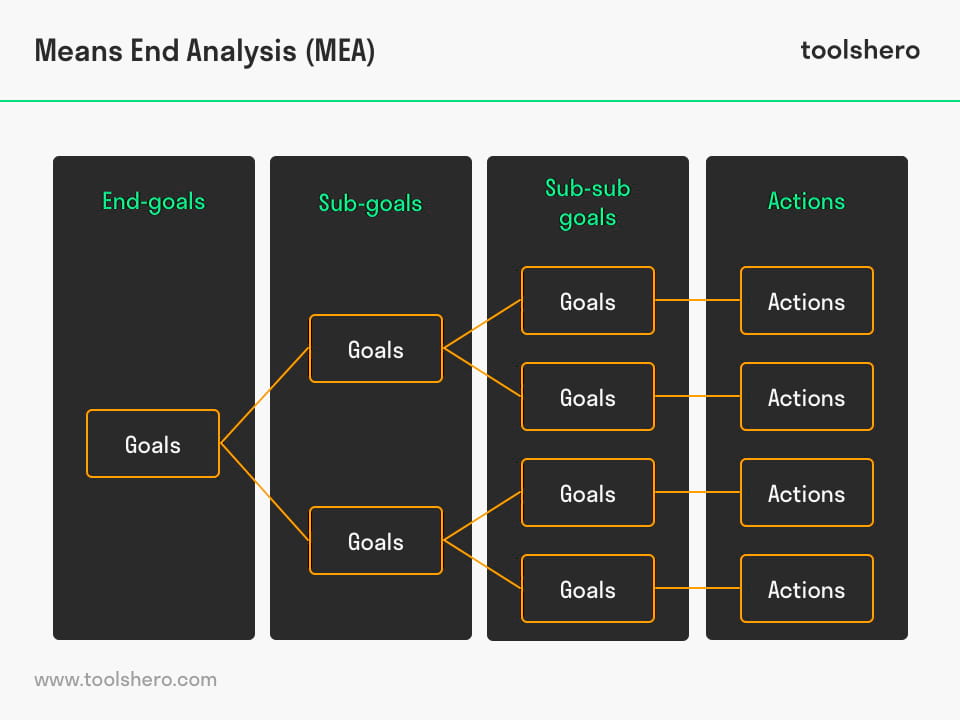
Figure 1 – an example overview of a Means End Analysis
Means End Analysis is about thoroughly thinking through which steps are needed in order to reach the end-goal.
Additionally, everyone within the organisation gets a reality check, because it shows that even the smallest steps have an impact on the overall goal that has been set .
It’s Your Turn
What do you think? Is Means End Analysis applicable in your personal or professional environment? Do you recognize the practical explanation or do you have more suggestions? What are your success factors for achieving end-goals??
Share your experience and knowledge in the comments box below.
More information
- Fikes, R. E., & Nilsson, N. J. (1971). STRIPS: A new approach to the application of theorem proving to problem solving . Artificial intelligence, 2(3-4), 189-208.
- Johnson, A. P. (2005). A short guide to action research . Boston: Pearson/ Allyn and Bacon .
- Sweller, J. (1988). Cognitive load during problem solving: Effects on learning . Cognitive science, 12(2), 257-285.
How to cite this article: Mulder, P. (2018). Means End Analysis (MEA) . Retrieved [insert date] from Toolshero: https://www.toolshero.com/problem-solving/means-end-analysis-mea/
Original publication date: 04/19/2018 | Last update: 01/25/2024
Add a link to this page on your website: <a href=”https://www.toolshero.com/problem-solving/means-end-analysis-mea/”> Toolshero: Means End Analysis (MEA)</a>
Did you find this article interesting?
Your rating is more than welcome or share this article via Social media!
Average rating 4.5 / 5. Vote count: 13
No votes so far! Be the first to rate this post.
We are sorry that this post was not useful for you!
Let us improve this post!
Tell us how we can improve this post?

Patty Mulder
Patty Mulder is an Dutch expert on Management Skills, Personal Effectiveness and Business Communication. She is also a Content writer, Business Coach and Company Trainer and lives in the Netherlands (Europe). Note: all her articles are written in Dutch and we translated her articles to English!
Related ARTICLES

Convergent Thinking: the Definition and Theory

Vilfredo Pareto biography, quotes and books

Root Cause Analysis (RCA): Definition, Process and Tools

Pareto Analysis explained plus example

Soft Systems Methodology (SSM) by Peter Checkland

CATWOE Analysis: theory and example
Also interesting.

PDCA Cycle by Deming: Meaning and Steps

Straw Man Proposal: The basics and template

TRIZ Method of Problem Solving explained
Leave a reply cancel reply.
You must be logged in to post a comment.
BOOST YOUR SKILLS
Toolshero supports people worldwide ( 10+ million visitors from 100+ countries ) to empower themselves through an easily accessible and high-quality learning platform for personal and professional development.
By making access to scientific knowledge simple and affordable, self-development becomes attainable for everyone, including you! Join our learning platform and boost your skills with Toolshero.

POPULAR TOPICS
- Change Management
- Marketing Theories
- Problem Solving Theories
- Psychology Theories
ABOUT TOOLSHERO
- Free Toolshero e-book
- Memberships & Pricing

Means-End Analysis in Psychology: A Powerful Problem-Solving Technique
From solving everyday dilemmas to unraveling the most perplexing enigmas, means-end analysis has emerged as a powerful problem-solving technique in the field of psychology. It’s a bit like having a mental Swiss Army knife, ready to tackle any challenge that comes your way. But what exactly is this nifty cognitive tool, and how can it help us navigate the labyrinth of life’s puzzles?
Imagine you’re standing at the foot of a towering mountain, your goal perched precariously at its peak. Means-end analysis is the rope, the harness, and the map that guides you to the summit. It’s a systematic approach that breaks down complex problems into manageable chunks, allowing us to plot a course from where we are to where we want to be.
Unraveling the Threads of Means-End Analysis
At its core, means-end analysis is a problem-solving strategy that involves identifying the current state, envisioning the desired goal state, and then methodically reducing the differences between the two. It’s like playing a game of “spot the difference,” but instead of circling discrepancies on a page, you’re actively working to eliminate them in real-life scenarios.
This technique didn’t just pop up overnight like a mushroom after rain. It has its roots deeply embedded in the fertile soil of cognitive psychology. The concept was first introduced by Allen Newell and Herbert A. Simon in the 1950s as part of their work on artificial intelligence and human problem-solving. These brilliant minds recognized that humans often approach problems by breaking them down into smaller, more manageable subgoals – a strategy that could be mimicked by computers to solve complex tasks.
But why should we care about means-end analysis? Well, it turns out that this approach is not just a fancy term psychologists throw around at cocktail parties. It’s a fundamental tool in our cognitive toolbox, one that we often use without even realizing it. From planning a vacation to navigating the stages of problem-solving in psychology , means-end analysis helps us tackle challenges with a structured, logical approach.
The Building Blocks of Means-End Mastery
Now, let’s roll up our sleeves and dig into the nitty-gritty of how means-end analysis actually works. It’s not rocket science, but it does require a bit of mental gymnastics.
First things first: you need to clearly define your starting point and your end goal. It’s like plotting your journey on a map – you can’t get directions if you don’t know where you’re coming from or where you’re headed. This step might seem obvious, but you’d be surprised how often people skip it and end up wandering in circles.
Once you’ve got your “Point A” and “Point B” sorted, it’s time to break down that daunting mountain of a problem into more manageable molehills. This is where the magic happens. By identifying subgoals, you create a series of stepping stones that lead you towards your ultimate objective. It’s like building a bridge across a raging river, one plank at a time.
The next step is where things get really interesting. You need to select the right tools – or “operators” in psych-speak – to reduce the differences between your current state and your goal state. These operators are the actions or strategies you can use to move closer to your objective. It’s a bit like choosing the right chess piece to make your next move.
But here’s the kicker: means-end analysis isn’t a one-and-done deal. It’s a recursive process, meaning you apply the same principles to each subgoal you encounter along the way. It’s like solving a Russian nesting doll of problems, each one revealing a smaller challenge inside.
The Cognitive Cogs Behind the Machine
Now that we’ve got the basics down, let’s peek under the hood and see what’s really going on in our brains when we engage in means-end analysis. It’s not just about following a set of steps – there’s a whole symphony of cognitive processes playing out in our minds.
First up, we’ve got working memory, the mental workspace where we juggle all the information needed to solve our problem. It’s like trying to keep a dozen plates spinning at once – the more complex the problem, the more plates we need to keep in the air. This is where cognitive load comes into play. Too much information, and our mental plates start crashing to the ground.
Then there’s the matter of problem representation and mental models. How we picture the problem in our minds can make or break our problem-solving efforts. It’s like trying to assemble a piece of IKEA furniture – if your mental image of how it should look is off, you might end up with a wonky bookshelf instead of a sleek coffee table.
Of course, our brains love to take shortcuts, and means-end analysis is no exception. We often rely on heuristics – mental rules of thumb – to guide our decision-making. These can be incredibly useful, like knowing to start with the corner pieces when solving a jigsaw puzzle. But they can also lead us astray, causing biases in our reasoning that might send us down the wrong path.
Expertise plays a crucial role in effective means-end analysis. It’s like the difference between a novice and a grandmaster in chess. The expert has a vast library of patterns and solutions to draw from, allowing them to quickly identify promising strategies and potential pitfalls. This is why analytical thinking in psychology is such a valuable skill to cultivate.
Means-End Analysis: Not Just for Lab Coats
You might be thinking, “That’s all well and good, but how does this apply to the real world?” Well, buckle up, because means-end analysis has applications across a wide range of domains, from the therapist’s couch to the boardroom table.
In clinical psychology, means-end analysis can be a powerful tool for therapeutic interventions. Imagine a person struggling with social anxiety. By breaking down the goal of “feeling comfortable in social situations” into smaller, manageable steps, a therapist can help their client gradually work towards overcoming their fears. It’s like building a staircase to climb out of the pit of anxiety, one step at a time.
Educational psychologists and instructional designers also leverage means-end analysis to create effective learning experiences. By identifying the gap between a student’s current knowledge and the desired learning outcomes, educators can design curricula that bridge that gap efficiently. It’s like creating a roadmap for knowledge, with clearly marked pitstops along the way.
In the corporate world, organizational psychologists use means-end analysis for strategic planning. By breaking down complex business goals into actionable steps, companies can navigate the choppy waters of the market more effectively. It’s like plotting a course through a storm – you might not be able to control the weather, but you can certainly plan your route.
Even in the realm of artificial intelligence, means-end analysis has found a home. Problem-solving algorithms often incorporate this technique to tackle complex tasks. It’s like teaching a computer to think like a human – or perhaps, teaching humans to think more like efficient problem-solving machines.
When Means-End Analysis Meets Its Match
Now, before you go thinking that means-end analysis is the be-all and end-all of problem-solving, let’s pump the brakes a bit. Like any tool, it has its limitations and has faced its fair share of criticism.
One of the main drawbacks is the potential for suboptimal solutions. Sometimes, in our eagerness to reach our goal, we might settle for the first solution that gets us there, even if it’s not the best one. It’s like taking a detour to avoid traffic, only to find that the longer route actually takes more time.
Means-end analysis can also struggle with ill-defined problems. When the goal state is fuzzy or the path to get there is unclear, this technique can leave us feeling a bit lost. It’s like trying to navigate using a map with half the landmarks missing.
There’s also the issue of cognitive strain and decision fatigue. Constantly breaking down problems and evaluating options can be mentally exhausting. It’s like trying to solve a Rubik’s cube for hours on end – eventually, your brain starts to feel like scrambled eggs.
Lastly, it’s important to recognize that not everyone approaches problem-solving in the same way. Cultural and individual differences can play a significant role in how effective means-end analysis is for different people. It’s a reminder that while this technique is powerful, it’s not a one-size-fits-all solution.
Sharpening Your Means-End Toolkit
So, how can we harness the power of means-end analysis while mitigating its drawbacks? Fear not, for there are ways to enhance our problem-solving prowess and make this technique work for us.
One approach is to combine means-end analysis with other problem-solving methods. For instance, integrating it with cost-benefit analysis in psychology can help ensure that we’re not just finding a solution, but finding the best solution. It’s like using a GPS that not only shows you the route but also factors in traffic, toll roads, and scenic views.
Practice makes perfect, and means-end analysis is no exception. There are training programs and exercises designed to develop these skills. It’s like going to the gym for your brain, building those problem-solving muscles one rep at a time.
As we look to the future, means-end analysis continues to evolve. Researchers are exploring new ways to apply this technique in fields ranging from artificial intelligence to climate change mitigation. It’s an exciting time for problem-solving enthusiasts, with new frontiers being explored and new challenges being tackled.
Wrapping Up: The Means to an End
As we reach the end of our journey through the landscape of means-end analysis, let’s take a moment to reflect on what we’ve discovered. This powerful problem-solving technique, born in the halls of cognitive psychology, has grown to become a versatile tool applicable in countless areas of life and work.
From breaking down complex problems into manageable chunks to navigating the intricate dance of cognitive processes, means-end analysis offers a structured approach to tackling life’s challenges. It’s a testament to the human capacity for logical thinking and creative problem-solving.
But remember, means-end analysis is just one tool in your cognitive toolkit. Like a skilled craftsman, the key is knowing when and how to use it effectively. Sometimes, you might need to combine it with other problem-solving techniques in psychology for optimal results.
As you go forth into the world, armed with this knowledge, keep an eye out for opportunities to apply means-end analysis in your daily life. Whether you’re planning a project at work, tackling a personal goal, or simply trying to figure out what to have for dinner, this technique can help you break down the problem and find a path forward.
In the end, means-end analysis is more than just a problem-solving strategy – it’s a way of thinking, a approach to life that empowers us to face challenges head-on and find creative solutions. So the next time you’re faced with a daunting task or a perplexing puzzle, remember: you’ve got the means to reach your end. Now go forth and conquer those problems!
References:
1. Newell, A., & Simon, H. A. (1972). Human problem solving. Prentice-Hall.
2. Anderson, J. R. (1993). Problem solving and learning. American Psychologist, 48(1), 35-44.
3. Sweller, J. (1988). Cognitive load during problem solving: Effects on learning. Cognitive Science, 12(2), 257-285.
4. Kahneman, D. (2011). Thinking, fast and slow. Farrar, Straus and Giroux.
5. Chi, M. T., Glaser, R., & Rees, E. (1982). Expertise in problem solving. In R. J. Sternberg (Ed.), Advances in the psychology of human intelligence (Vol. 1, pp. 7-75). Lawrence Erlbaum Associates.
6. Gick, M. L., & Holyoak, K. J. (1980). Analogical problem solving. Cognitive Psychology, 12(3), 306-355.
7. Greeno, J. G. (1978). Natures of problem-solving abilities. In W. K. Estes (Ed.), Handbook of learning and cognitive processes (Vol. 5, pp. 239-270). Lawrence Erlbaum Associates.
8. Simon, H. A. (1996). The sciences of the artificial (3rd ed.). MIT Press.
9. Novick, L. R., & Bassok, M. (2005). Problem solving. In K. J. Holyoak & R. G. Morrison (Eds.), The Cambridge handbook of thinking and reasoning (pp. 321-349). Cambridge University Press.
10. Sternberg, R. J., & Grigorenko, E. L. (2000). Teaching for successful intelligence: To increase student learning and achievement. Corwin Press.
Similar Posts

Applied Behavioral Science vs Psychology: Key Differences and Similarities
From influencing public policy to driving personal growth, the fascinating worlds of applied behavioral science and psychology offer transformative insights into the human mind and behavior. These two fields, while closely related, have distinct characteristics that set them apart. Yet, they also share common ground, creating a rich tapestry of knowledge that continues to shape…

Psychological Tricks to Manipulate: Unveiling the Power of Persuasion
The art of persuasion is a double-edged sword, and those who master its subtle techniques wield a formidable power over the minds of others. This power, however, comes with great responsibility and ethical considerations that cannot be ignored. In a world where influence is currency, understanding the intricacies of psychological manipulation has become both a…

Psychology and STEM: Exploring the Intersection of Science and Human Behavior
From the debate halls of academia to the cutting-edge laboratories of neuroscience, the question of psychology’s place within the STEM fields has ignited a passionate discourse that challenges our understanding of the very nature of scientific inquiry. This ongoing discussion has sparked intense debates among scholars, researchers, and policymakers alike, as they grapple with the…

Expectancy Psychology: Definition, Concepts, and Real-World Applications
From shaping our motivation and goal-setting to influencing treatment outcomes and athletic performance, the power of expectancy weaves through the fabric of our lives, silently guiding our thoughts, emotions, and behaviors. It’s a force so subtle yet profound that we often overlook its impact on our daily experiences. But make no mistake, expectancy is the…

Misery Loves Company: Psychological Insights into a Common Phrase
The familiar adage “misery loves company” encapsulates a profound truth about human nature, revealing the complex psychological forces that drive us to seek solace in shared sorrow. This age-old saying, believed to have originated in the 14th century, continues to resonate with people across cultures and generations. Its enduring relevance speaks to a fundamental aspect…

Interactionist Perspective in Psychology: Exploring Social Dynamics and Behavior
In the intricate dance of social interactions, the interactionist perspective in psychology unravels the complex tapestry of human behavior, shedding light on the dynamic interplay between individuals and their social world. This fascinating approach to understanding human nature has captivated researchers and laypeople alike, offering a unique lens through which we can examine the nuances…
Leave a Reply Cancel reply
Your email address will not be published. Required fields are marked *
Save my name, email, and website in this browser for the next time I comment.

- History & Society
- Science & Tech
- Biographies
- Animals & Nature
- Geography & Travel
- Arts & Culture
- Games & Quizzes
- On This Day
- One Good Fact
- New Articles
- Lifestyles & Social Issues
- Philosophy & Religion
- Politics, Law & Government
- World History
- Health & Medicine
- Browse Biographies
- Birds, Reptiles & Other Vertebrates
- Bugs, Mollusks & Other Invertebrates
- Environment
- Fossils & Geologic Time
- Entertainment & Pop Culture
- Sports & Recreation
- Visual Arts
- Demystified
- Image Galleries
- Infographics
- Top Questions
- Britannica Kids
- Saving Earth
- Space Next 50
- Student Center
- Introduction
Characteristics and process
Applications.
- When did science begin?
- Where was science invented?

means-ends analysis
Our editors will review what you’ve submitted and determine whether to revise the article.
- Table Of Contents
means-ends analysis , heuristic , or trial-and-error, problem-solving strategy in which an end goal is identified and then fulfilled via the generation of subgoals and action plans that help overcome obstacles encountered along the way. Solving a problem with means-ends analysis typically begins by examining the end goal and breaking it down into subgoals. Actions needed to achieve each subgoal are then developed. In some cases, subgoals are further broken down into sub-subgoals. When all of the subgoals have been achieved (or obstacles eliminated), the end goal has been met.
The idea of problem solving by means-ends analysis was introduced in 1972 by American computer scientists Allen Newell and Herbert A. Simon in their book Human Problem Solving . They developed the theory in the late 1950s and early ’60s while generating a computer model capable of simulating human problem solving, working with John Clifford Shaw, a scientist and computer expert at the RAND Corporation , where beginning in 1950 Newell also worked as a researcher. The scientists called their model the General Problem Solver (GPS). GPS would recursively apply heuristic techniques in solving a given problem and conduct a means-ends assessment after each subproblem was solved to determine whether it was closer to the intended solution. Through this process, GPS could find solutions to mathematical theorems, logical proofs, word problems, and a wide variety of other well-defined problems. (Newell and Simon received the 1975 Turing Award for their research pertaining to human cognition and artificial intelligence .)
Means-ends analysis is unique among problem-solving algorithms in that it emphasizes the generation of subgoals that directly contribute to reaching the end goal. The subgoals are not necessarily of the same type. In other approaches, namely divide-and-conquer, subproblems are created that are then solved recursively and are finally combined to solve the end problem; with divide-and-conquer, the subproblems are always of the same type.
An example of the process of carrying out means-ends analysis can be illustrated by using the end goal of having a well-designed, well-functioning website. Possible subgoals and sub-subgoals include:
technical setup, such as choosing a web hosting service, registering a domain name , and setting up the hosting environment and linking the domain;
design, involving the creation of a layout for the homepage, the creation of landing pages and interior pages, the selection of a colour scheme and typography, and the design of menus, buttons, and other interactive elements;
coding, with a need to learn coding languages and the coding and implementation of interactive elements;
content development, such as writing content and gathering images and videos;
testing browser compatibility, with testing of the website on different browsers and on different devices; and
testing and debugging to make sure the website functions properly, test interactive elements, and fix formatting issues, bugs, or inconsistencies.
Means-ends analysis is frequently used in artificial intelligence (AI) systems. As a goal-based problem-solving technique, it plays a significant role in creating AI systems that exhibit humanlike behaviour, because the algorithmic steps involved in the analysis simulate aspects of human cognition and problem-solving skills. AI systems also use means-ends analysis for limiting searches in programs by evaluating the difference between the current state of a problem and the goal state, while using a combination of backward and forward search techniques.
Businesses and organizations use means-ends analysis for planning, project management, and transformation projects. In project management, for example, means-end analysis can be used to break down complex projects into subprojects and then to track the progress of those subprojects. It is used in transformation projects to implement changes to business processes by splitting new processes into subprocesses.
Research has been conducted on applying means-ends analysis to product marketing campaigns for brand persuasion purposes. For example, in the 1990s, researchers applied means-ends analysis to study how consumers link a product’s attributes with the consequences (benefits) of using the product and how the attributes and consequences align with personal values. Such studies supported the effectiveness of means-ends analysis in brand persuasion. Later research confirmed the effectiveness of means-ends analysis and its suitability for a wide range of marketing applications and suggested the development of additional methodologies for analyzing observations.

Exploring Means-End Analysis in Psychology

Means-End Analysis is a powerful problem-solving and decision-making tool used in psychology. In this article, we will delve into the steps of Means-End Analysis, its benefits, criticisms, and its application in therapy.
We will explore how it helps in resolving conflicts, understanding motivations, and its limitations in therapy. We will discuss the future of Means-End Analysis in psychology. Join us as we uncover the fascinating world of Means-End Analysis and its impact in the field of psychology.
- 1 Key Takeaways:
- 2 What is Means-End Analysis?
- 3.1 What are the Steps of Means-End Analysis?
- 4.1 How Does Means-End Analysis Help in Problem Solving?
- 4.2 How Does Means-End Analysis Help in Decision Making?
- 5.1 Is Means-End Analysis Applicable to All Situations?
- 5.2 Does Means-End Analysis Consider Emotional Factors?
- 6.1 Can Means-End Analysis Help in Resolving Conflicts?
- 6.2 Can Means-End Analysis Help in Understanding Motivations?
- 7 What are the Limitations of Using Means-End Analysis in Therapy?
- 8 What is the Future of Means-End Analysis in Psychology?
- 9.1 What is Means-End Analysis in Psychology?
- 9.2 How is Means-End Analysis different from other problem-solving techniques?
- 9.3 What are the key components of Means-End Analysis?
- 9.4 How is Means-End Analysis used in real-life situations?
- 9.5 What are the benefits of using Means-End Analysis in problem-solving?
- 9.6 Are there any limitations to using Means-End Analysis?
Key Takeaways:
- Means-end analysis is a problem-solving technique used in psychology to break down complex problems into smaller, more manageable steps.
- It helps individuals understand their motivations and make effective decisions by identifying and linking their desired outcomes with the necessary actions to achieve them.
- While means-end analysis has its limitations, it has shown promise in therapy by aiding conflict resolution and gaining insight into personal motivations. Its future in psychology is promising as it continues to be studied and refined.
What is Means-End Analysis?
Means-End Analysis is a problem-solving technique commonly used in artificial intelligence and psychology, rooted in the cognitive basis of human cognition.
This method involves breaking down a problem into smaller sub-goals, then devising actions to achieve these sub-goals, ultimately leading to the solution of the main problem.
In the realm of AI, this approach is instrumental in the development of intelligent systems that can emulate human problem-solving processes. By imitating the means-ends analysis, AI systems can simulate human-like cognitive skills, enabling them to handle complex problems and decision-making tasks with greater efficiency.
How is Means-End Analysis Used in Psychology?
Means-End Analysis plays a pivotal role in psychology, particularly in understanding the cognitive structure and processes involved in problem-solving and decision-making.
It is frequently utilized as a strategy to solve problems by breaking them into smaller, more manageable tasks, and linking these tasks through a series of means to an end goal.
In research, means-ends analysis provides valuable insights into the patterns of thinking and problem-solving approaches employed by individuals across different scenarios.
By studying how individuals employ this method, psychologists gain a deeper understanding of cognitive functioning, problem-solving strategies, and decision-making processes.
What are the Steps of Means-End Analysis?
Means-End Analysis involves several key steps, including identifying subgoals, applying heuristic strategies, and implementing transformations within the cognitive structure map.
Subgoal identification is the first step in the means-end analysis process. This involves breaking down the main goal into smaller, more manageable subgoals, allowing for a more focused approach to problem-solving and decision-making.
Heuristic approaches, such as using rules of thumb or mental shortcuts, can aid in identifying potential solutions and guiding decision-making. Cognitive structure transformations involve reorganizing the mental representation of the problem, which can lead to new insights and approaches to achieving the overall goal.
What are the Benefits of Using Means-End Analysis?
The application of means-ends analysis offers significant benefits, including enhanced involvement in consumer behavior, driving technology innovation, and facilitating effective product marketing.
By systematically and analytically assessing the relationship between consumer desires, the available means to satisfy them, and the end goals, means-ends analysis allows companies to gain valuable insights into consumer decision-making processes.
This approach enables organizations to develop innovative technological solutions that address consumer needs, preferences, and pain points, thereby driving technological advancements in various industries.
When applied to product marketing , means-ends analysis enables marketers to create compelling messaging, product positioning, and value propositions that resonate deeply with consumers, leading to improved market penetration and customer acquisition.
How Does Means-End Analysis Help in Problem Solving?
Means-End Analysis serves as a valuable tool in problem-solving, particularly in project management scenarios, by leveraging best practices and honing cognitive skills.
By breaking down a complex goal into a series of smaller sub-goals, means-ends analysis facilitates a systematic approach to finding solutions for intricate issues.
This method involves assessing the current state, determining the desired end state, and strategically identifying the means to bridge the gap between the two.
In project management, this approach allows teams to methodically address challenges, allocate resources efficiently, and make informed decisions based on a comprehensive understanding of the project’s objectives.
How Does Means-End Analysis Help in Decision Making?
Means-End Analysis contributes to knowledge-based decision making processes in various contexts, providing a structured approach for evaluating concepts, optimizing organizational strategies, and guiding developers in technology innovation.
This cognitive problem-solving technique involves breaking down a problem into subgoals and identifying the steps needed to achieve each one.
By applying means-end analysis, individuals and organizations can gain valuable insights into complex systems, anticipate potential obstacles, and devise efficient pathways to reach desired outcomes.
In evaluating concepts, means-end analysis enables a thorough examination of the relationships between components and their implications, fostering a deeper comprehension of ideas and their potential impacts.
When applied to organizational strategies, means-end analysis aids in identifying opportunities for improvement, optimizing resource allocation, and aligning actions with long-term objectives.
For technology developers, this approach serves as a guiding framework, allowing for systematic exploration of design possibilities, anticipating user needs, and mitigating potential technical barriers.
What are the Criticisms of Means-End Analysis?
Means-End Analysis has faced criticisms regarding its applicability to all situations, the consideration of emotional factors, and the methodology for addressing implications in complex problem-solving scenarios.
One of the criticisms of Means-End Analysis is that it may not be universally applicable to all problem-solving situations. While it can be effective in certain structured and well-defined problems, its relevance in more dynamic and ambiguous situations has been questioned.
The approach’s treatment of emotional factors has been criticized for its limited consideration of human emotions, social influences, and subjective experiences, which are essential elements in many real-world problem-solving contexts.
Critics also raise concerns about the methodological implications, emphasizing the need for a more comprehensive and integrated approach that encompasses both rational analysis and emotional intelligence.
Is Means-End Analysis Applicable to All Situations?
The applicability of means-ends analysis to all situations remains a subject of scrutiny, with considerations about its cognitive basis, innovative potential, and alignment with core values.
Means-ends analysis, a cognitive problem-solving technique rooted in psychology, constitutes a versatile framework applicable across diverse contexts. Its cognitive basis lies in breaking down larger goals into manageable sub-goals, facilitating problem-solving and decision-making processes.
The innovative potential of means-ends analysis manifests in its adaptability to complex problems, fostering creative problem-solving approaches and promoting efficient resource utilization.
In addition, the alignment of means-ends analysis with core values is evident in its emphasis on promoting ethical decision-making, consideration of long-term consequences, and fostering a comprehensive understanding of outcomes.
Does Means-End Analysis Consider Emotional Factors?
The consideration of emotional factors within means-ends analysis involves evaluating consequences, understanding involvement groups, and aligning with cognitive structure dynamics to address holistic problem-solving scenarios.
When addressing the emotional factors in means-ends analysis, it is essential to assess the potential repercussions of the decisions made. Understanding the emotional impact on individuals and groups involved is crucial, as it can greatly influence the success or failure of the strategy.
Aligning with the cognitive structure dynamics ensures that the decision-making process integrates the emotional aspects effectively, leading to a well-rounded and comprehensive problem-solving approach. By taking into account the emotional nuances, means-ends analysis can be optimized for more successful outcomes.
How is Means-End Analysis Used in Therapy?
Means-End Analysis finds application in therapy by addressing values , implications, and attributes within the cognitive basis of individuals, promoting comprehensive problem-solving strategies.
When incorporated into therapy, Means-End Analysis offers a structured approach that is grounded in the fundamental principles of understanding and addressing individual values, cognitive attributes, and their implications.
By exploring the relationship between the present state and the desired outcome, therapists can guide their clients through a process that encourages introspection and self-discovery.
This method provides a framework for individuals to recognize and evaluate the barriers, challenges, and potential solutions, ultimately fostering a sense of enablement and autonomy in addressing their issues.
Can Means-End Analysis Help in Resolving Conflicts?
Means-End Analysis offers a structured approach to resolving conflicts, emphasizing the evaluation of consequences, fostering innovation, and addressing behavioral dynamics within conflict resolution scenarios.
By incorporating Means-End Analysis into conflict resolution, individuals can assess the potential outcomes of various actions, enabling them to make informed decisions based on the probable consequences.
This method encourages a forward-thinking mindset, promoting the exploration of creative and adaptive solutions to conflicts.
By understanding the behavioral dynamics at play, parties involved in the conflict can identify potential triggers and develop strategies to minimize escalation and promote constructive dialogue.
Can Means-End Analysis Help in Understanding Motivations?
Means-End Analysis plays a pivotal role in understanding motivations, leveraging strategic analysis, technological implications, and cognitive dynamics to comprehend individual and collective motivational factors.
Understanding human behavior involves a systematic approach. This approach looks at the relationships between people’s goals, the means they use to achieve those goals, and the obstacles they face.
Analysts can use this approach to delve into the complex web of interconnected motivations, behaviors, and decision-making processes. This sheds light on the underlying cognitive mechanisms that influence human actions.
What are the Limitations of Using Means-End Analysis in Therapy?
The utilization of means-ends analysis in therapy presents limitations related to involvement dynamics, value considerations, and the complexity of cognitive structure mapping within therapeutic interventions.
When employing means-ends analysis in therapy, practitioners must navigate the intricate web of client involvement dynamics, which can significantly impact the effectiveness of the approach.
Value considerations play a pivotal role as well, as they vary greatly among individuals and can influence the interpretation and prioritization of goals and subgoals.
The cognitive structure map within therapy can present complexities, as it encompasses the intricate interplay of thoughts, emotions, beliefs, and behaviors, requiring a nuanced understanding and careful navigation.
What is the Future of Means-End Analysis in Psychology?
The future landscape of means-ends analysis in psychology holds promising prospects, driven by advancements in artificial intelligence, transformative methodologies, and profound implications for problem-solving paradigms.
As AI continues to evolve, it has the potential to revolutionize the means-ends analysis approach by enhancing cognitive processes and decision-making capabilities.
Transformative methodologies such as machine learning and natural language processing are expanding the boundaries of problem-solving paradigms, offering innovative solutions and insights in psychological research.
The integration of AI technologies with traditional means-ends analysis has the potential to unlock new understandings of complex human behaviors and cognitive processes, paving the way for groundbreaking advancements in psychology.
Frequently Asked Questions
What is means-end analysis in psychology.
Means-End Analysis is a problem-solving technique used in psychology to break down complex tasks into smaller, more manageable steps. It involves identifying the ultimate goal or end result, and then determining the means or steps needed to achieve it.
How is Means-End Analysis different from other problem-solving techniques?
Unlike other problem-solving methods that focus on trial and error or intuition, Means-End Analysis is based on a systematic and logical approach. It involves breaking down a problem into smaller parts, and then using previous knowledge and experience to find a solution.
What are the key components of Means-End Analysis?
There are three main components of Means-End Analysis: the goal, the obstacles, and the operations. The goal is the desired outcome, the obstacles are the barriers that prevent achieving the goal, and the operations are the actions or steps needed to overcome the obstacles and reach the goal.
How is Means-End Analysis used in real-life situations?
Means-End Analysis can be applied in various real-life situations, such as decision-making, conflict resolution, and goal setting. It can also be used in therapy to help individuals break down their problems and find effective solutions.
What are the benefits of using Means-End Analysis in problem-solving?
Means-End Analysis allows for a more structured and organized approach to problem-solving, which can increase the chances of finding a successful solution. It also promotes critical thinking and the use of previous knowledge and experience.
Are there any limitations to using Means-End Analysis?
While Means-End Analysis can be a useful technique, it may not be suitable for all types of problems. It requires a certain level of cognitive ability and may not be effective in situations where emotions or impulsivity play a significant role. Additionally, it may take longer to implement than other problem-solving methods.

Dr. Naomi Kessler is a forensic psychologist with extensive experience in criminal behavior analysis and legal consultancy. Her professional journey includes working with law enforcement agencies, providing expert testimony in court cases, and conducting research on the psychological profiles of offenders. Dr. Kessler’s writings delve into the intersection of psychology and law, aiming to shed light on the complexities of human behavior within the legal system and the role of psychology in justice and rehabilitation.
Similar Posts
Understanding Approach-Avoidance Conflict in Psychology: Implications and Effects
The article was last updated by Julian Torres on February 6, 2024. Approach-avoidance conflict is a common psychological phenomenon that many of us experience in…
Exploring the Foundations of Happiness Psychology
The article was last updated by Dr. Emily Tan on February 4, 2024. Have you ever wondered what truly makes us happy? Happiness psychology delves…
Exploring the Psychology Behind What You See First in Pictures
The article was last updated by Gabriel Silva on February 4, 2024. Have you ever wondered why you are drawn to certain elements in a…
Exploring Conditioning in Psychology
The article was last updated by Julian Torres on February 5, 2024. Curious about the concept of conditioning in psychology? This article will take you…
The Significance of Music Psychology in the Broad Field of Psychology
The article was last updated by Ethan Clarke on February 8, 2024. Have you ever wondered how music can impact our brain, emotions, and overall…
Exploring Computational Modeling in Psychology: Tools and Applications
The article was last updated by Rachel Liu on February 8, 2024. Have you ever wondered how psychologists study and understand human behavior? Computational modeling…
Unsupported browser
This site was designed for modern browsers and tested with Internet Explorer version 10 and later.
It may not look or work correctly on your browser.
- Business Plans
What Is a Means-End Analysis? & How to Use It
It’s tough to know how to track progress and identify key milestones. The solution is to apply a means end analysis (MEA.)

If you’re tasked with a project, you know it takes several steps to bring to life. But at first, it can seem overwhelming to map out the path to success.
Means end analysis problem solving drives creative solutions. Most big goals worth having aren’t easily achieved. And without an action plan, you’ll likely never get there. But with means end analysis problem solving and this article, every challenge becomes solvable!
What Is a Means-End Analysis? (And When Should You Use One?)
Here's the secret of why means end analysis problem solving works: it uses a final result as a starting point .
Think about that for a moment. When you tackle most projects, you might be tempted to start by tackling the problems in your path. It's easy to let your mind go directly to the obstacles. That's a surefire way to become overwhelmed by what stands between you and your goal.
But what if we reversed that model? A means to end analysis does just that. It starts with a focus on your goal, then helps you see the steps needed to get there. Means end analysis problem solving is equally useful for project tracking and management.

A means to end analysis first considers your objective, the goal that you have for your task or project. Then, it helps you illustrate the journey to the goal. Means end analysis uses actions (means) to tell you how to achieve your goal (the end).
Means end analysis uses actions (means) to tell you how to achieve your goal (the end).
Means end analysis is very useful. You should use it any time you’re working on a project that requires many steps to complete. The analysis has been popular since the mid-twentieth century.
Often, you’ll means-end analysis used in computers and engineering to help study decision points and actions. But remember, means end analysis works well for projects in any field. The ultimate goal of means end analysis is to spark creativity.
Here are principles to keep in mind while you learn about means-end analysis. There are many project management approaches. Here are principles that set means-end apart:
- Actions taken along the way to the goal are labeled “sub-goals.”
- Sub-goals take the form of specific action items that can be delegated to members of your team.
- These sub-goals are set to enable tracking so that you monitor implementation progress.
- Goals are best paired with specific metrics . These metrics help you monitor progress by quantifying actual results with data.
This is the true value of means end analysis. If you need to figure out how to reach a goal, try means to end analysis to plot your journey. And if you already know the specific steps, use MEA to fuel creativity and accountability for you and your team.

Finally, don’t consider means end analysis as a limited tool. It supports projects and goals large and small. It’s essentially a tree structure that can contain as many branches and nodes as you need. It can evolve over time.
You may identify subgoals that later grow their own sub-sub-goals. MEA is a flexible tool that you can adapt perfectly to fit your needs. It’s a powerful, easy-to-use decision tool to use in 2022.
How to Create a Means-End Analysis
Once you’ve decided to use means to end analysis, it’s time to build out a visual example. There are many tools that work for means end analysis problem solving. One efficient way to do this is with a PowerPoint deck. The app is easy to work with, and helps you share your MEA design with others.

For this example, I’ll use the Infographic PowerPoint template from Envato Elements. Elements has thousands of premium PPT templates to choose from, with unlimited downloads for a flat rate.
1. Select a Process-Focused Slide for Means End Analysis
For our means end analysis example, let’s begin with slide #27 in the deck. This one is arranged as a process map. Notice the series of linear steps connected with an arrow. You can use this layout to create and devise means end analysis with a series of sub-goals or actions.

This example has six different steps. Remember, the last “step” is actually your goal. It’s the objective of your project. Thus, it’s a good idea to start your MEA design by filling in the goal.
2. Fill In Your Goals
Notice on the slide here that there's already text in place. A hallmark of premium templates, this is placeholder text. To customize the means end analysis slide, you’ll swap out the placeholders for your own content.
To do that, click into a text box and select the contents inside. Then, start typing over them with your keyboard. The existing words will vanish, replaced with your own. Type in your goal and add some optional supporting text to add context.

With the end goal in place, you’ve laid the foundation for your means end analysis.
3. Set Your Sub-Goals
Now, it’s time to build out the bulk of the analysis by identifying and labeling sub-goals. Remember, sub-goals are the building blocks of our overall strategy. Each one is a milestone (“mean”) necessary for your goal (the “end) to be achieved.
It’s easiest here to start back at the beginning. Means end analysis problem solving takes you through an entire project, from start to finish. The first sub-goal should be the first step you must take to begin the project.
As an example, let’s add step #1 in. For simplicity in this example, I’ll label the first node Product Design . Again, this is done by swapping out the existing text for your own words. Think of what this is saying: the first thing we must do to meet our goal is design a new product.

Again, sub-goals will vary in every means end analysis. The trick is to brainstorm every part of what makes your project successful. Every step that must be taken to succeed should be identified and labeled as a subgoal.
4. Add Your Metrics
As you can see below, it’s also helpful to add metrics. These help track progress in every subgoal. After all, without a clear objective how do you know when you've achieved a sub-goal? Fill in your subgoals on your analysis template until you’ve completed the full layout.
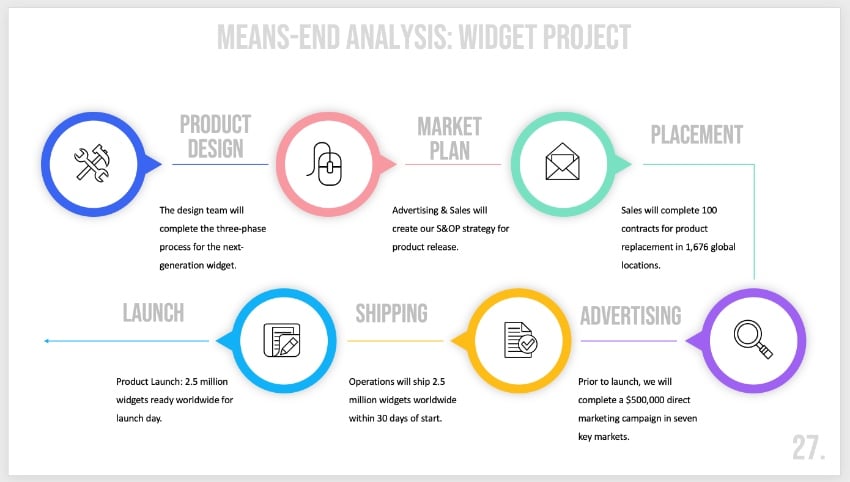
With a premium template like this, you can craft an amazing means end analysis quickly. Your finished product is a stylish design to share with your team to lead a successful project.
Tips for How to Approach a Means-End Analysis
You’ve seen how a means to end analysis helps make decisions and guide teams through projects. But to succeed with them, it pays to embrace some ground rules. These are general techniques that help you create a useful means end analysis. Keep them in mind as you work.
1. Understand Your Stakeholders
The first tip is to engage with stakeholders. This is most important if your project requires the input of multiple team members. Even if you’re the project manager, it might be tough to think of every sub-goal needed. So be sure to talk with key stakeholders from each functional area involved in the project.
Learn more about stakeholder analysis with the help of this tutorial. It can be a helpful precursor to preparing your means to end analysis.
2. Be Specific
General sub-goals are okay, so long as they represent categories. Painting sub-goals with a broad brush can lead to missing key details.
3. Keep Your Means End Analysis Up-To-Date
Never think of a means end analysis as static. The analysis will evolve as your goals and projects evolve. Some sub-goals may become unnecessary. Or you may realize new actions to take along the way.

Revisit the analysis and update the lists of actions and sub-goals as they change and develop. The PowerPoint-based approach in this article helps you to keep your analysis flexible.
4. Collaborate
Remember to use means end analysis as a motivator. In the scope of a giant project or task, individuals may lose sight of their importance. The MEA demonstrates how every piece of the project fits together.
Finally, don’t forget to share your analysis. It’s much more than a theoretical exercise. In fact, your MEA is a project roadmap useful for sharing with all stakeholders. It drives accountability, translating to results and successful goal attainment.
5. Implement Your Means Analysis
Always consider means end analysis as a way to improve processes. What the activity really does is drive a complete look at goal attainment.
Question underlying assumptions. Are you building in sub-goals that aren’t actually needed? Use the analysis as an opportunity to streamline your workflow.

A cohesive analysis shows that goal attainment is impossible without attaining each sub-goal. No sub-goal alone completes a project. But no goal can be completed without completing all sub-goals. Make sure to share your analysis with team members to give them credit for their hard work.
With these tips and ideas, your means end analysis problem solving will be more effective. Plus, you’ll work more efficiently as you create your analysis and pursue your goal.

The Best Source for Means to End Analysis PowerPoint Templates (With Unlimited Use)
There are many tools that you can use to create means to end analysis plans. As you saw in this tutorial, PowerPoint gives you a flexible way to update your analysis as it evolves. On Envato Elements , you tap into the best PowerPoint templates, perfect for means end analysis.

Envato Elements is a project manager's best friend. With unlimited access to graphics, web templates, video footage, and so much more. Besides presentation templates, these assets are all included for one flat rate.

Join Elements today and get access to everything. You're on your way to great project management with the help of the Elements library.
Need templates for project management, but don't want a subscription? GraphicRiver is the perfect choice for you. Download a single design and start your project immediately, no subscription required.
Start Your Means End Analysis Problem Solving Now
Now, you've got one more tool in your belt to problem solve. You can see that means to end analysis is a unique way to break down a problem into goals and sub-goals. By applying this approach, even large projects become manageable.
Remember: this format helps you focus on your ultimate goal. That keeps you motivated. Follow the steps and example that you saw in this tutorial today, and you're on your way!
Editorial Note: This content was originally published in April 2022. We're sharing it again because our editors have determined that this information is still accurate and relevant.


Means-Ends Analysis

Updated June 28, 2023
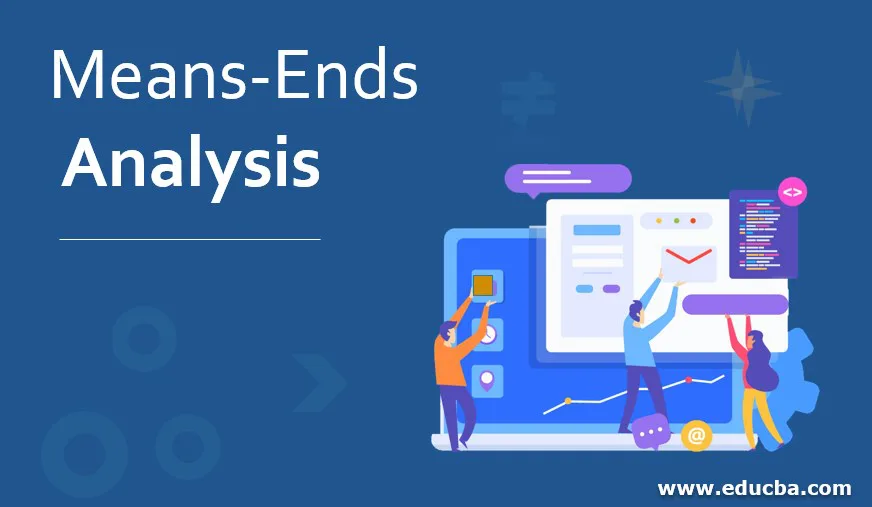
Introduction to Means-Ends Analysis
Means-End Analysis is a problem-solving technique that identifies the current state, defines the end goal, and determines the modular action plan to reach the end state. Split the End Goals into sub-goals and sub-sub goals, and then draw action plans to achieve sub-goals first and then progress towards achieving the main goal. Most of the problem-solving strategies will have either forward actions or backward actions.
Start Your Free Data Science Course
Hadoop, Data Science, Statistics & others
But MEA will have a mixture of action plans in either of the directions to solve the problems modularly, in the sense that it attempts to solve the significant problems first and get back to minor issues later or vice versa. Means-End Analysis (MEA) finds application in AI programming, General Management, and Psychology as a problem-solving technique. Let us study its features in detail in this article.
What is Problem Solving?
Problem-solving has a different meaning in several contexts. As part of Artificial Intelligence , computer science refers to applying algorithms, heuristics, and root cause analysis to find solutions. Psychology deals with the logic of cognitively reaching a desired goal state from the problematic current state through introspection, analysis, and experimentation.
The problem-solving activity starts with gathering data on the problem using surveys, Brainstorming, and identifying gaps. Failure Mode Effects analysis helps to identify potential problems in a system. The next step involves analyzing the gathered data using tools such as the Fishbone diagram, Pareto chart, etc., to identify a solution.
Where is it used?
Means-End Analysis is used in the following disciplines:
- MEA is a creative problem-solving technique used in Artificial Intelligence applications for a long time. From the search space of possible solutions available in the system, AI selects the best possible solution by applying the right search strategy or algorithm. This algorithm deals with an initial and end state, the action plan, and movement in forward and backward directions. This recursive algorithm optimizes the search operation and achieves the end goal with minimum effort.
- In the General Management area, MEA facilitates organization planning to attain goals. We split goals into objectives and then divide each objective into action steps. Breaking goals into actionable tasks helps management reach the end state successfully.
- MEA helps implement Business transformation projects by identifying as it is a state, defining to state, and listing the new business processes to be developed. For effective implementation, further split these new processes into sub-processes.
- One can also follow the MEA methodology to solve problems or attain a specific goal. It helps to manage overwhelming situations by clearly understanding the reasons for the current status and reaching the end status by executing the planned actions. MEA helps in avoiding frustrations and mental depression and leading a peaceful life.
How does the Means-Ends Analysis work?
Let’s learn how it works.
- Measures the current state and identifies the problems and pain points faced in the current state.
- Defines the to-be state (goal state) to be reached.
- Splits the goals into sub-goals and sub-goals into further sub-sub-goals. To illustrate, we can divide long-term goals into short-term goals and continue the subdivision process.
- The desired outcome requires identifying the necessary steps to achieve it.
- Connect each sub-goal with executable actions.
- Includes all intermediate steps and relevant actions to address the issues faced in the current state.
- It makes these steps detectable and device ways and means to track even small changes in the actual and to-be state.
Takes corrective actions wherever it is required MEA steps are depicted below:
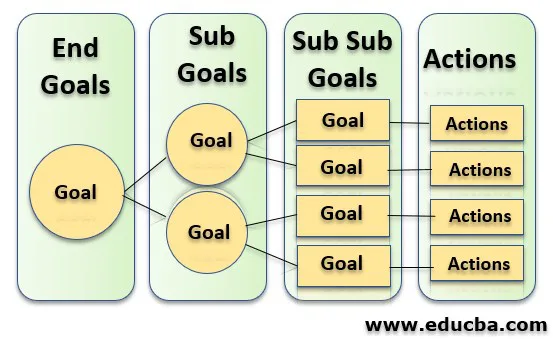
Algorithm for Means-Ends Analysis
The algorithm provides the best possible solution to a problem and contains the well-defined step-by-step correct resolution to a given problem. One should blindly follow this mathematical template of steps and expect it to produce the end results. We can use these algorithms as input to develop computer programs and implement solutions. Each and every step can have test cases built for it, and the program can undergo thorough testing before implementation. When solving a problem, logical steps guarantee a solution. In contrast, heuristics rely on trial and error, past experience, and judgmental methods, which may not always produce a guaranteed solution.
In general, we use algorithms where we expect accurate results and where the time to complete the activity is not a significant criterion. When completing tasks, people use heuristics to save time and can tolerate a few errors. In planned activity (e.g., Organization Planning), we deploy algorithms; in emergency activity (e.g., a Physician treating a patient should decide on the treatment quickly), we use heuristics.
The algorithm for MEA consists of the following steps:
- Step 1: Measure the current state of things by doing as is the study and capture the status at a macro level and a possible micro level.
- Step 2: Capture the deficiency in the current state and avenues for improvements (wish list) and define the goal state (to-be state). Define the to-be state at a macro level and a possible micro level.
- Step 3: Compare the Current and Goal states; if they are at the same level, the problem is resolved.
- Step 4: List the differences between the current and goal states at macro and micro levels.
- Step 5: Convert the differences into deletions/modifications to the current state and new additions.
- Step 6: Define the action to implement the changes as defined in step-5.
- Step 7: Implement the changes and measure the results with the planned goals.
- Step 8: Do course correction and achieve the final goal.
Artificial Intelligence applications, General Management scenarios, and phycology use cases to deploy the MEA algorithm step selectively and recursively in achieving the end goal.
The means-End analysis provides a logical action plan to overcome any problems in General Management, Personal life. In AI, MEA offers a methodology to optimize search operations to save time and effort.
Recommended Articles
This is a guide to the Means-Ends Analysis. Here we discuss how it is used, working and the algorithm of Means-Ends Analysis. You may also look at the following articles to learn more-
- What is Artificial Intelligence?
- Categories of Artificial Intelligence Algorithm
- Top Companies of Artificial Intelligence
- Features of Hill Climbing in Artificial Intelligence
By signing up, you agree to our Terms of Use and Privacy Policy .

*Please provide your correct email id. Login details for this Free course will be emailed to you
Forgot Password?
This website or its third-party tools use cookies, which are necessary to its functioning and required to achieve the purposes illustrated in the cookie policy. By closing this banner, scrolling this page, clicking a link or continuing to browse otherwise, you agree to our Privacy Policy

Explore 1000+ varieties of Mock tests View more
Submit Next Question
Early-Bird Offer: ENROLL NOW

CAFÉ Toolkit
You are here, problem solving using means-end analysis, definition of a problem.
Conventional problem solving occurs in both everyday life and professional life.
Problems may range from getting to work on time after sleeping through an alarm, making a birthday cake for next Saturday, marking all assignments by next week and placating an irate customer complaining of poor customer service …who is at the front desk, yelling …now!
Truth be known, whether these are indeed examples of a problem which needs to be solved or whether in fact these are just examples of “routines” that have been prepared for in advance, depend entirely on the knowledge base of the person presented with these tasks to perform.
If any of these situations trigger a response procedure determined by an underlying knowledge base of what to do, then it is not a problem solving activity at all. Rather, it is the execution of a “routine procedure” held as prior knowledge in long term memory.
A problem solving activity is only required if a person does not know an appropriate response to the set task. That is, when you are tasked with responding to a situation that you do not actually know the solution for, then, and only then, will you need to engage in conventional problem solving.
Trial and Error
One method of problem solving is by trial and error. Most people understand trial and error and will use it in some situations. By way of example, if faced with two taps in a foreign bathroom, not knowing which is the tap for ‘hot water’ then trial and error may be a practical strategy. After all, there are only two alternatives presented and if your first attempt at determining a solution is incorrect then there is a very high likelihood that you will now have determined the tap that you seek.
However, for each of the example problems listed above for both everyday life and professional life, trial and error is not likely to be used. If it is used, then at best it will likely be inefficient and it is also likely that it will be ineffective. For the example problems trial and error will likely result in a late arrival at work, a birthday cake that no one wants to eat, late marking of some assignments, incomplete accounts by end of year and a very dissatisfied customer.
When presented a novel problem, the solution to which is not “known” people spontaneously use means-ends analysis to solve it.
Means-ends analysis
Means-ends analysis is a very effective strategy for determining a solution path to a novel problem. Means-ends analysis typically involves some backwards working from the goal to the givens in order to identify the solution path.
However, means-ends analysis is very intensive upon cognitive resources. Although solutions are often determined using this strategy, it is not effective at producing learning of the solution path. When presented a similar problem again in the future people often “re-solve” it again, using means-ends analysis, rather than having developed a suitable associated knowledge base that drives a forward working “routine” response .
Conventional problem solving imposes high levels of cognitive load. The following describes and demonstrates the dynamics of a means-ends analysis.
Problem solving using means-ends analysis
Means-ends analysis is a problem solving heuristic (strategy) which is widely used to solve conventional problems by people who are not highly familiar with the specific problem type (Larkin, McDermott, Simon & Simon, 1980; Simon & Simon, 1978).
Means-ends analysis is based upon the principle of reducing differences between the current problem state (which begins at the problem givens) and the goal state. In practice, this procedure often results in a problem solver working backwards from the goal to the problem givens, before then working forwards from the givens to the goal.
While this strategy is very effective in obtaining answers (assigning a value to a goal state) it has a necessary consequence of inducing very high levels of cognitive load. This is because the nature of the strategy requires attention to be directed simultaneously to the current state, the goal state, differences between them, procedures to reduce those differences and any possible subgoals that may lead to solution. Full details of how means-ends analysis operates, and its consequences for working memory, are presented in Sweller (1988).
Example of a conventional problem solved using means-ends analysis
Next: The principles of cognitive load theory
Larkin, H., McDermott, J.,Simon, D., & Simon, H. (1980). Models of competence in solving physics problems. Cognitive Science, 11 ,65-99.
Simon, D. P., & Simon, H. A. (1978). Individual differences in solving physics problems. In R.S. Seigler (Ed.), Children's thinking : What develops ? Hillsdale, NJ : Lawerence Erlbaum Associates.
Sweller, J. (1988). Cognitive load during problem solving : Effects on learning. Cognitive Science, 12, 257-285.
Sweller, J., & Levine, M. (1982). Effects of sub-goal density on means-ends analysis and learning. Journal of Experimental Psychology : Human Learning and Memory, 8, 463-474.
Copyright © 2024, CAFÉ Toolkit
Heuristics and Problem Solving
- Reference work entry
- pp 1421–1424
- Cite this reference work entry

- Erik De Corte 2 ,
- Lieven Verschaffel 2 &
- Wim Van Dooren 2
547 Accesses
3 Citations
Definitions
In a general sense heuristics are guidelines or methods for problem solving. Therefore, we will first define problem solving before presenting a specific definition of heuristics.
Problem Solving
In contrast to a routine task, a problem is a situation in which a person is trying to attain a goal but does not dispose of a ready-made solution or solution method. Problem solving involves then “cognitive processing directed at transforming the given situation into a goal situation when no obvious method of solution is available” (Mayer and Wittrock 2006 , p. 287). An implication is that a task can be a problem for one person, but not for someone else. For instance, the task “divide 120 marbles equally among 8 children” may be a problem for beginning elementary school children, but not for people who master the algorithm for long division, or know how to use a calculator.
The term “heuristic” originates from the Greek word heuriskein which means “to find.” Heuristics ...
This is a preview of subscription content, log in via an institution to check access.
Access this chapter
Subscribe and save.
- Get 10 units per month
- Download Article/Chapter or eBook
- 1 Unit = 1 Article or 1 Chapter
- Cancel anytime
- Available as PDF
- Read on any device
- Instant download
- Own it forever
- Available as EPUB and PDF
- Durable hardcover edition
- Dispatched in 3 to 5 business days
- Free shipping worldwide - see info
Tax calculation will be finalised at checkout
Purchases are for personal use only
Institutional subscriptions
De Corte, E., Verschaffel, L., & Op’t Eynde, P. (2000). Self-regulation: a characteristic and a goal of mathematics education. In M. Boekaerts, P. R. Pintrich, & M. Zeidner (Eds.), Handbook of self-regulation (pp. 687–726). San Diego, CA: Academic.
Google Scholar
De Corte, E., Verschaffel, L., & Masui, C. (2004). The CLIA-model: a framework for designing powerful learning environments for thinking and problem solving. European Journal of Psychology of Education, 19 , 365–384.
Article Google Scholar
Dignath, C., & Büttner, G. (2008). Components of fostering self-regulated learning among students. a meta-analysis on intervention studies at primary and secondary school level. Metacognition and Learning, 3 , 231–264.
Groner, R., Groner, M., & Bischof, W. F. (Eds.). (1983). Methods of heuristics . Hillsdale, NJ: Erlbaum.
Mayer, R. E., & Wittrock, M. C. (2006). Problem solving. In P. A. Alexander & P. H. Winne (Eds.), Handbook of educational psychology (pp. 287–303). New York: Macmillan.
Polya, G. (1945). How to solve it . Princeton, NJ: Princeton University Press.
Schoenfeld, A. H. (1985). Mathematical problem solving . New York: Academic.
Download references
Author information
Authors and affiliations.
Department of Education, Center for Instructional Psychology and Technology (CIP&T), Katholieke Universiteit Leuven, Dekenstraat 2, P.O. box 3773, B-3000, Leuven, Belgium
Dr. Erik De Corte, Prof. Dr. Lieven Verschaffel & Wim Van Dooren
You can also search for this author in PubMed Google Scholar
Corresponding author
Correspondence to Erik De Corte .
Editor information
Editors and affiliations.
Faculty of Economics and Behavioral Sciences, Department of Education, University of Freiburg, 79085, Freiburg, Germany
Norbert M. Seel
Rights and permissions
Reprints and permissions
Copyright information
© 2012 Springer Science+Business Media, LLC
About this entry
Cite this entry.
De Corte, E., Verschaffel, L., Van Dooren, W. (2012). Heuristics and Problem Solving. In: Seel, N.M. (eds) Encyclopedia of the Sciences of Learning. Springer, Boston, MA. https://doi.org/10.1007/978-1-4419-1428-6_420
Download citation
DOI : https://doi.org/10.1007/978-1-4419-1428-6_420
Publisher Name : Springer, Boston, MA
Print ISBN : 978-1-4419-1427-9
Online ISBN : 978-1-4419-1428-6
eBook Packages : Humanities, Social Sciences and Law Reference Module Humanities and Social Sciences Reference Module Education
Share this entry
Anyone you share the following link with will be able to read this content:
Sorry, a shareable link is not currently available for this article.
Provided by the Springer Nature SharedIt content-sharing initiative
- Publish with us
Policies and ethics
- Find a journal
- Track your research
What is means-ends analysis?
In today's fast-paced and complex world, problem-solving skills are crucial for success in various domains. Means-ends analysis (MEA) is an effective problem-solving approach that involves dividing a problem into smaller goals and identifying the means that stand in the way of the current state and the desired goal.
The means-end analysis utilizes the following steps to achieve goals.

Artificial Intelligence
- Artificial Intelligence (AI)
- Applications of AI
- History of AI
- Types of AI
- Intelligent Agent
- Types of Agents
- Agent Environment
- Turing Test in AI
Problem-solving
- Search Algorithms
- Uninformed Search Algorithm
- Informed Search Algorithms
- Hill Climbing Algorithm
- Means-Ends Analysis
Adversarial Search
- Adversarial search
- Minimax Algorithm
- Alpha-Beta Pruning
Knowledge Represent
- Knowledge Based Agent
- Knowledge Representation
- Knowledge Representation Techniques
- Propositional Logic
- Rules of Inference
- The Wumpus world
- knowledge-base for Wumpus World
- First-order logic
- Knowledge Engineering in FOL
- Inference in First-Order Logic
- Unification in FOL
- Resolution in FOL
- Forward Chaining and backward chaining
- Backward Chaining vs Forward Chaining
- Reasoning in AI
- Inductive vs. Deductive reasoning
Uncertain Knowledge R.
- Probabilistic Reasoning in AI
- Bayes theorem in AI
- Bayesian Belief Network
- Examples of AI
- AI in Healthcare
- Artificial Intelligence in Education
- Artificial Intelligence in Agriculture
- Engineering Applications of AI
- Advantages & Disadvantages of AI
- Robotics and AI
- Future of AI
- Languages used in AI
- Approaches to AI Learning
- Scope of AI
- Agents in AI
- Artificial Intelligence Jobs
- Amazon CloudFront
- Goals of Artificial Intelligence
- Can Artificial Intelligence replace Human Intelligence
- Importance of Artificial Intelligence
- Artificial Intelligence Stock in India
- How to Use Artificial Intelligence in Marketing
- Artificial Intelligence in Business
- Companies Working on Artificial Intelligence
- Artificial Intelligence Future Ideas
- Government Jobs in Artificial Intelligence in India
- What is the Role of Planning in Artificial Intelligence
- AI as a Service
- AI in Banking
- Cognitive AI
- Introduction of Seaborn
- Natural Language ToolKit (NLTK)
- Best books for ML
- AI companies of India will lead in 2022
- Constraint Satisfaction Problems in Artificial Intelligence
- How artificial intelligence will change the future
- Problem Solving Techniques in AI
- AI in Manufacturing Industry
- Artificial Intelligence in Automotive Industry
- Artificial Intelligence in Civil Engineering
- Artificial Intelligence in Gaming Industry
- Artificial Intelligence in HR
- Artificial Intelligence in Medicine
- PhD in Artificial Intelligence
- Activation Functions in Neural Networks
- Boston Housing Kaggle Challenge with Linear Regression
- What are OpenAI and ChatGPT
- Chatbot vs. Conversational AI
- Iterative Deepening A* Algorithm (IDA*)
- Iterative Deepening Search (IDS) or Iterative Deepening Depth First Search (IDDFS)
- Genetic Algorithm in Soft Computing
- AI and data privacy
- Future of Devops
- How Machine Learning is Used on Social Media Platforms in 2023
- Machine learning and climate change
- The Green Tech Revolution
- GoogleNet in AI
- AlexNet in Artificial Intelligence
- Basics of LiDAR - Light Detection and Ranging
- Explainable AI (XAI)
- Synthetic Image Generation
- What is Deepfake in Artificial Intelligence
- What is Generative AI: Introduction
- Artificial Intelligence in Power System Operation and Optimization
- Customer Segmentation with LLM
- Liquid Neural Networks in Artificial Intelligence
- Propositional Logic Inferences in Artificial Intelligence
- Text Generation using Gated Recurrent Unit Networks
- Viterbi Algorithm in NLP
- What are the benefits of Artificial Intelligence for devops
- AI Tech Stack
- Speech Recognition in Artificial Intelligence
- Types of AI Algorithms and How Do They Work
- AI Ethics (AI Code of Ethics)
- Pros and Cons of AI-Generated Content
- Top 10+ Jobs in AI and the Right Artificial Intelligence Skills You Need to Stand Out
- AIOps (artificial intelligence for IT operations)
- Artificial Intelligence In E-commerce
- How AI can Transform Industrial Safety
- How to Gradually Incorporate AI in Software Testing
- Generative AI
- NLTK WordNet
- What is Auto-GPT
- Artificial Super Intelligence (ASI)
- AI hallucination
- How to Learn AI from Scratch
- What is Dilated Convolution?
- Explainable Artificial Intelligence(XAI)
- AI Content Generator
- Artificial Intelligence Project Ideas for Beginners
- Beatoven.ai: Make Music AI
- Google Lumiere AI
- Handling Missing Data in Decision Tree Models
- Impacts of Artificial Intelligence in Everyday Life
- OpenAI DALL-E Editor Interface
- Water Jug Problem in AI
- What are the Ethical Problems in Artificial Intelligence
- Difference between Depth First Search, Breadth First Search, and Depth Limit Search in AI
- How To Humanize AI Text for Free
- 5 Algorithms that Demonstrate Artificial Intelligence Bias
- Artificial Intelligence - Boon or Bane
- Character AI
- 18 of the best large language models in 2024
- Explainable AI
- Conceptual Dependency in AI
- Problem characteristics in ai
- Top degree programs for studying artificial Intelligence
- AI Upscaling
- Artificial Intelligence combined with decentralized technologies
- Ambient Intelligence
- Federated Learning
- Neuromorphic Computing
- Bias Mitigation in AI
- Neural Architecture Search
- Top Artificial Intelligence Techniques
- Best First Search in Artificial Intelligence
- Top 10 Must-Read Books for Artificial Intelligence
- What are the Core Subjects in Artificial Intelligence
- Features of Artificial Intelligence
- Artificial Intelligence Engineer Salary in India
- Artificial Intelligence in Dentistry
- des.ai.gn - Augmenting Human Creativity with Artificial Intelligence
- Best Artificial Intelligence Courses in 2024
- Difference Between Data Science and Artificial Intelligence
- Narrow Artificial Intelligence
- What is OpenAI
- Best First Search Algorithm in Artificial Intelligence
- Decision Theory in Artificial Intelligence
- Subsets of AI
- Expert Systems
- Machine Learning Tutorial
- NLP Tutorial
- Artificial Intelligence MCQ
Related Tutorials
- Tensorflow Tutorial
- PyTorch Tutorial
- Data Science Tutorial
- Reinforcement Learning
| . The means-ends analysis process can be applied recursively for a problem. It is a strategy to control search in problem-solving. Following are the main Steps which describes the working of MEA technique for solving a problem. In the MEA process, we detect the differences between the current state and goal state. Once these differences occur, then we can apply an operator to reduce the differences. But sometimes it is possible that an operator cannot be applied to the current state. So we create the subproblem of the current state, in which operator can be applied, such type of backward chaining in which operators are selected, and then sub goals are set up to establish the preconditions of the operator is called . Let's we take Current state as CURRENT and Goal State as GOAL, then following are the steps for the MEA algorithm. Compare CURRENT to GOAL, if there are no differences between both then return Success and Exit. Else, select the most significant difference and reduce it by doing the following steps until the success or failure occurs.And , are successful, then signal Success and return the result of combining FIRST-PART, O, and LAST-PART. The above-discussed algorithm is more suitable for a simple problem and not adequate for solving complex problems. Let's take an example where we know the initial state and goal state as given below. In this problem, we need to get the goal state by finding differences between the initial state and goal state and applying operators. To solve the above problem, we will first find the differences between initial states and goal states, and for each difference, we will generate a new state and will apply the operators. The operators we have for this problem are: In the first step, we will evaluate the initial state and will compare the initial and Goal state to find the differences between both states. As we can check the first difference is that in goal state there is no dot symbol which is present in the initial state, so, first we will apply the to remove this dot. After applying the Delete operator, the new state occurs which we will again compare with goal state. After comparing these states, there is another difference that is the square is outside the circle, so, we will apply the . Now a new state is generated in the third step, and we will compare this state with the goal state. After comparing the states there is still one difference which is the size of the square, so, we will apply , and finally, it will generate the goal state. |
Latest Courses

We provides tutorials and interview questions of all technology like java tutorial, android, java frameworks
Contact info
G-13, 2nd Floor, Sec-3, Noida, UP, 201301, India
[email protected] .

Latest Post
PRIVACY POLICY
Interview Questions
Online compiler.
- Docs »
- Georgia Tech OMSCS »
- Knowledge Based AI - CS7376-O01 »
- 05 - Means-End Analysis
- Edit on GitHub
05 - Means-End Analysis ¶

01 - Preview ¶

Today we will discuss two other very general AR methods of problem solving called means end analysis and problem reduction.
Like [INAUDIBLE] these two methods, means analysis and problem reduction, are really useful for very well-formed problems.
Not all problems are well-formed. But some problems are. And then these methods are very useful. These three methods, generate and test, means-ends analysis, form reduction, together with semantic networks as a knowledge representation, form the basic unit of all fundamental topics in this course.
We’ll begin with the notion of state spaces. Then talk about means-end analysis.
Then we’ll illustrate means-end analysis as a matter for solving problems and then we’ll move onto the method of problem reduction.
02 - Exercise The Block Problem ¶

To understand a method of means and analysis. Let us look at this blocks word problem. This is a very famous problem in AI. It has occurred again and again. And almost every textbook in AI has this problem. You’re given a table on which there are three blocks. And A is on table, B is on table, and
C is on A. This is the initial state. And you want to move these blocks, to the gold state. On this configuration, so that C is on table, B is on C and
A is on B. The problem looks very simple listen, doesn’t it?
Let’s introduce a couple of constraints.
You may move only one block at a time, so you can’t pick both A and B together.
And second, you may only move a block that has nothing on top of it. So, you cannot move block A in this configuration, because it has C on top of it.
Let us also suppose that we’re given some operators in this world.
These operators essentially move some object to some location. For example, we could move C to the table, or C onto B, or C onto A.
Not all the operators may be applicable in the current state. C is already on A, but in principle, all these, all of these operators are available. Given these operators, and this initial state and this goal state, write a sequence of operations that will move the blocks from the initial state to the goal state.
03 - Exercise The Block Problem ¶
>> That’s a good answer, David, that’s a correct answer.
Now the question becomes how can we make in AI agent that will come up with the similar sequence of operations? In particular, how does the matter of means-end analysis work on this problem and come up with a particular sequence of operations?
04 - State Spaces ¶
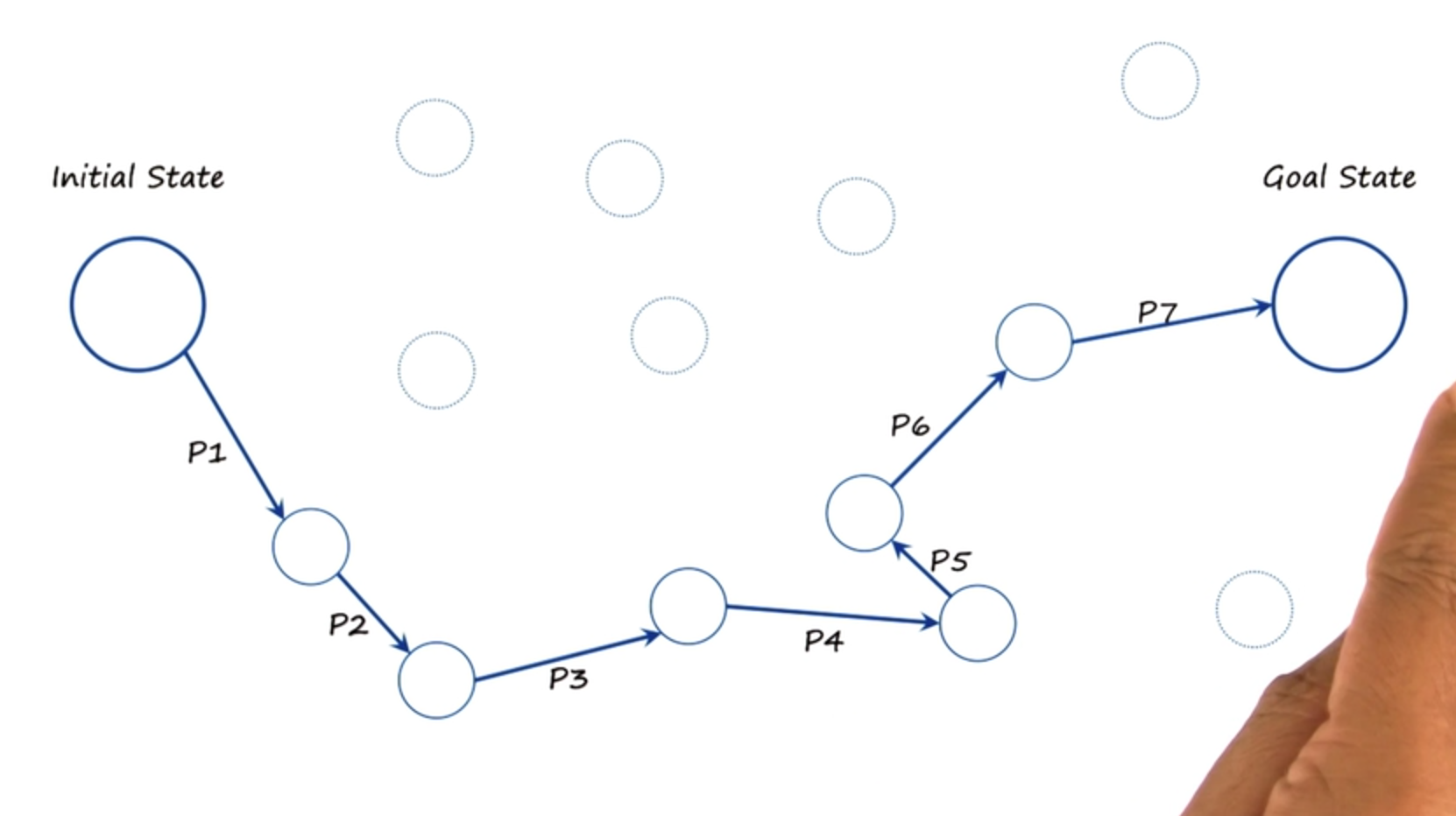
So, we can imagine problem solving as occurring in a state space.
Here is the initial state, here is the goal state. And the state space consists of all of the states that could be potentially produced from the initial state by iterative application of the various operators in this micro world. I want to come up with a path in the state space, takes me from initial state to the goal state. There is one path, this is not the only path, but this is one path to go from the initial state to the goal state. The question then becomes, how might an AI agent derive this path that may take it from the initial state to the goal state.
Let us see how this notion of path finding applies to our blocks world problem.
>From the initial state, here it is one path of going to the goal state. First, we put C on the table. Then we put B on top C. And then we put A on top of B.
Which is exactly the answer that David had given. This is one sequence, one path from the initial state to the goal state. The question then becomes, how does AI method know what operation to select in a given state?
Consider this state, for example. There are several operations possible here.
One could put C on top of B or B on top of A.
How does the AI agent know which operation to select at this particular state?
05 - Differences in State Spaces ¶

One way of thinking about this is to talk in terms of differences. This chart illustrates the differences between different states and the goal state. So, for example, if the current state was this one then this red line illustrates the difference from the goal state. So we should pick an operator that will help reduce the difference between the current state and the goal state.
So the reduction between the difference with the current state and the goal state is the end. The application of the operator is the means.
That’s why it’s called the means-ends analysis. At any given state,
I’m going to pick an operator that will help you deduce the difference between the current state and the goal state. Note in a way this problem is similar to the problem of part finding in robotics, where we have to design a robot that could go from one point to another point in some navigation space.
>From my office to your office, for example, if all our offices were in the same building. There too we would use the notion of distances between offices. Here we using the notion of distance in a metaphorical sense, in a figurative sense, not in a physical sense. So I’ll sometimes use the word difference instead of distance but it’s the same idea. We are trying to deduce the distance or the difference but in an abstract space. So going back to an example of going from this initial state to this goal state. I can look at initial state and see that there are three differences between the initial state and the goal state. First, A is on table here, but A should be on B.
B is on table here, but B should be on C. And third, C is on top of A here, the C should be on top, on table there. So three differences. Here the number of operations are available to us. Nine operations in particular. Let us do a means- end analysis. We can apply an operator that would put C on table.
In which case the difference between the new state and the goal state will be two. We could apply an operator that will put C on top of B, in that case the difference between the current state and the goal state will still be three. Or we can apply the operator putting B on top of C, in which case the distance between the current state and the goal state will be 2. Notice that the notion of reducing differences now leads to two possible choices. One could go with this state or with this one.
Means-end analysis by itself does not help an AI agent decide between this course of action and that course of action. This is something that we will return to, both a little bit later in this lesson and even much more in detail when we come to planning in this course. For now, let us resume that we choose the top course of action just like they had done already there. So this chart illustrates the pot taken from the initial state to the goal state.
And the important thing to notice here is that with each different move the distance between the current state and the goal state is decreasing, from three to two to one to zero. This is why means-end analysis comes up with this path because at each time it reduces a difference
06 - Process of Means End Analysis ¶

We can summarize the means-ends analysis method like this.
Compare the current state and the goal state. Find the differences between them. For each difference, look at what operators might be applicable. Select that operator that gets you closest to the goal state from the current state. We did this for the blocks and worlds problem. We also did this with regards to the business problem. But throughout those states in regards to business problem, which we’re not getting us close to the goal state. This is the means-ends analysis method in summary.
07 - Exercise Block Problem I ¶

To understand more deeply the properties of means and analysis, let us look at another, slightly more complicated example. In this example, there are four blocks instead of the three in the previous example. A, B,
C, D. In the initial state, the blocks are arranged as shown here.
The goal state is shown here on the right. The four blocks are arranged in a particular order. Now if you compare the configuration of blocks on the left with the configuration of blocks on the right, in the goal state, you can see there are three differences. First, A is on Table, where A is on B here. B is on C. That’s not a difference. C is on Table.
C is on D here, D’s on B, D’s on Table here. So there are three differences.
So, this is a heuristic measure of the difference between the initial state and the goal state. Once again, we’ll assume that the AI agent can move only one block at a time.
Given the specification of the problem, what states are possible from the initial state? Please write down your answers in these boxes.
08 - Exercise Block Problem I ¶
>> That’s good David.
09 - Exercise Block Problem II ¶

Okay now for each of these states that is possible from the initial state what are the differences as compared to the goal state?
Please write down your answers in these boxes.
10 - Exercise Block Problem II ¶
>> Good, David. So in each state David is comparing the state with the goal state and finding differences between them.
11 - Exercise Block Problem III ¶
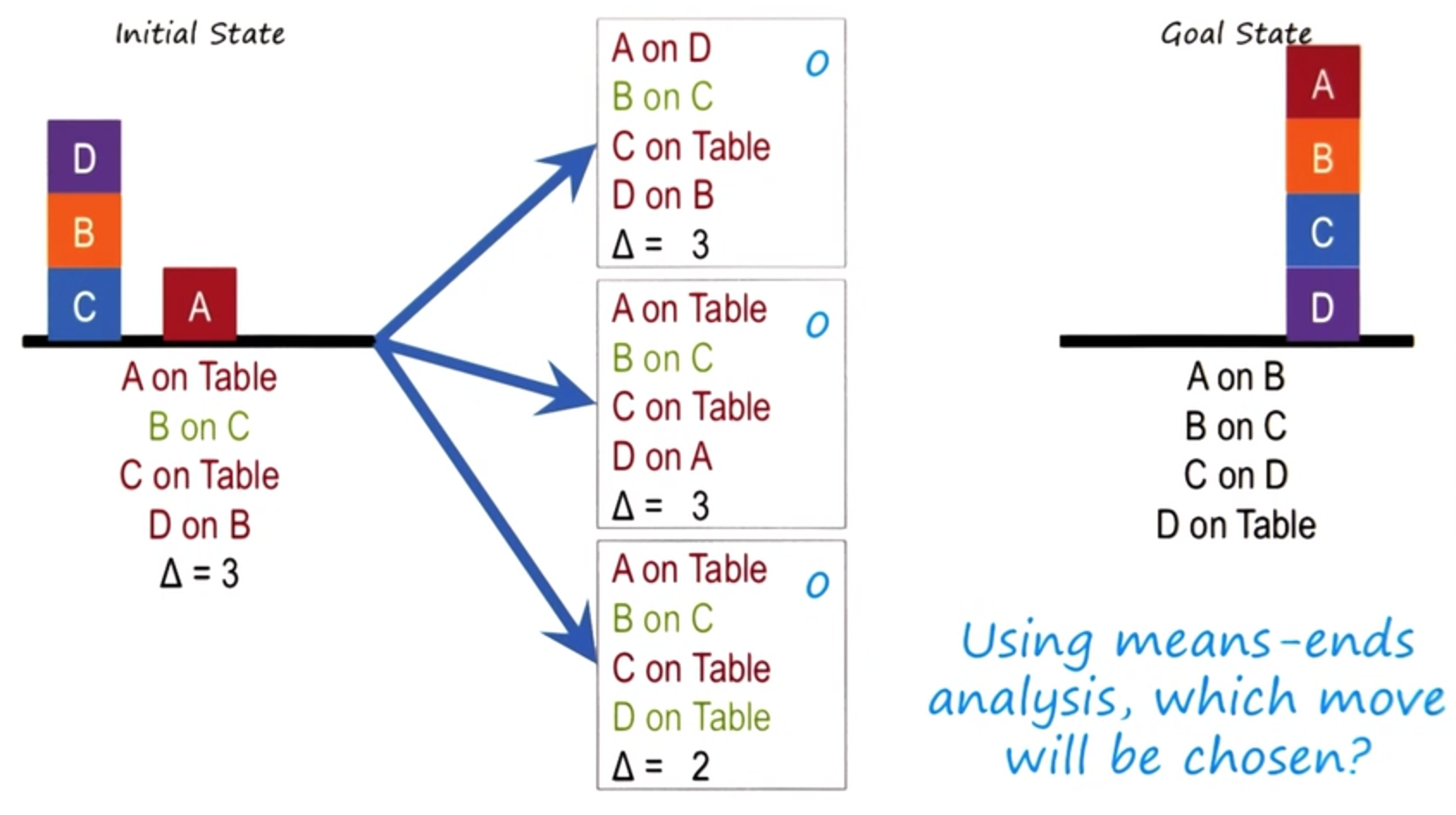
Given these three choices which operation would means-end analysis choose?
12 - Exercise Block Problem III ¶
>> That’s correct, David
13 - Exercise Block Problem IV ¶
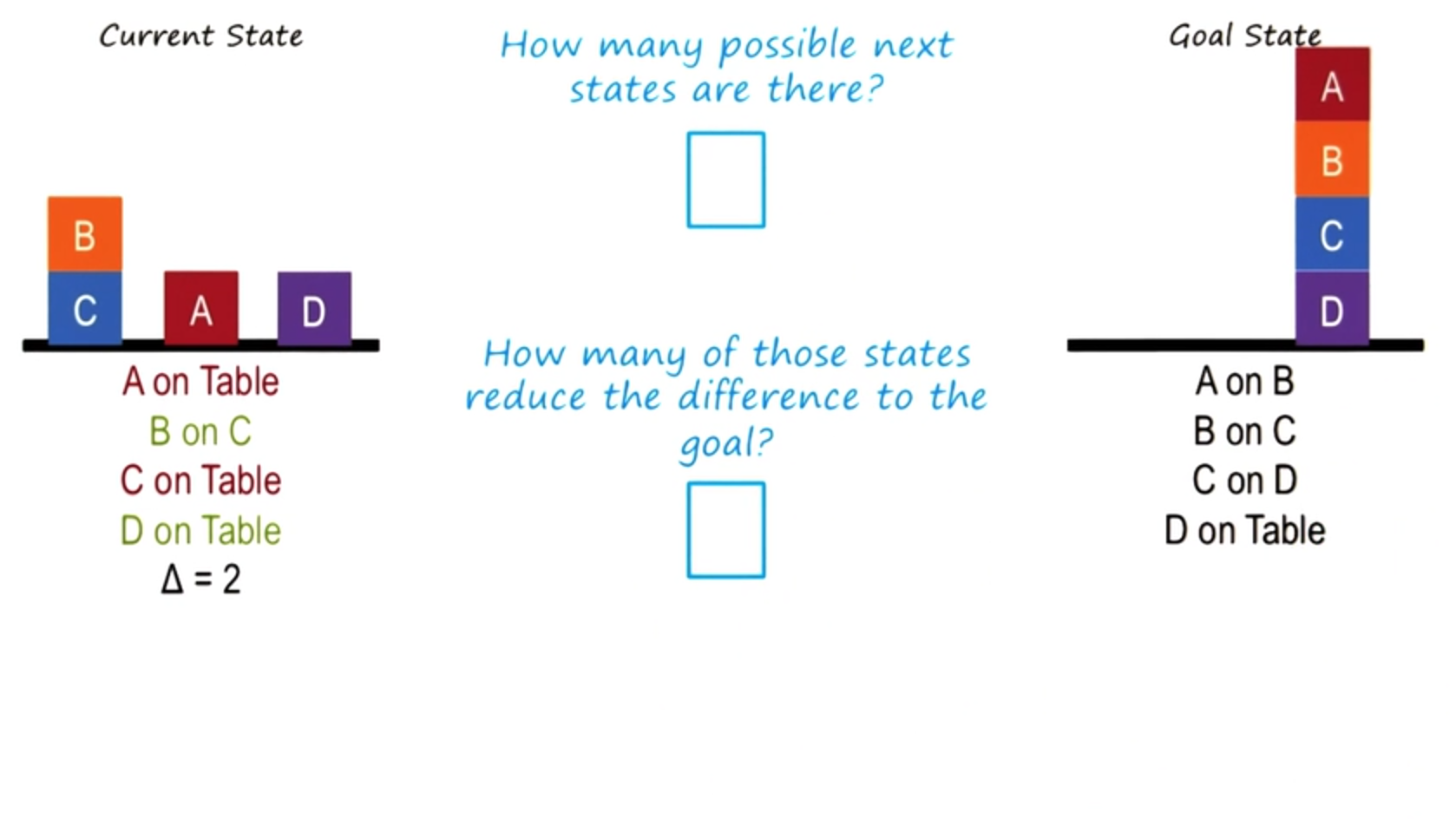
Given this current state, we can apply means ends analysis veritably.
Now, if we apply means on some of those to this particular state, the number of choices here is very large, so I will not go through all of them here.
But I’d like you to write down the number of possible next states. As well as, how many of those states reduce the difference to the goal? Which is given here.
14 - Exercise Block Problem IV ¶
>> That’s good, David.
15 - Exercise Block Problem V ¶

So, the operation of putting A on B will bring us to this state.
Given this state, we can have, again, apply a means of analysis. Again, I’m not sure that all these states here, but
I’d like you to find out how many possible states are there and how many of those states reduce the difference to the goal described.
16 - Exercise Block Problem V ¶
>> That’s right David and that means that means-ends analysis doesn’t not always take us to what’s the goal. Sometimes it can take us away from the goal.
And sometimes means-end analysis can get caught in loops. Means-end analysis, like genetic and test, is an example of universal error methods.
These universal error methods are applicalbe to very large classes of problems.
However, they can rate few guarantees of success, and they’re often very costly. They’re costly in terms of computational efficiency.
They neither provide any guarantees of computational efficiency, nor provide any guarantees of the optimality of the solution that they come up with.
Their power lies in the fact that they can be applied to a very large class of problems. Later in this class, we’ll discuss problem-solving methods, which are very specialized problem-solving methods.
Those methods are applicable to a smaller class of problems. However, they are more tuned to those problems and often are more efficient and sometimes, also provide guarantees over the optimality of the solution.
Although means-end analysis did not work very for this problem. It in fact works quite well for many other problems and therefore is an important AI method.
Later in this class when we come to planning, we will look at more powerful specialized methods that can in fact address this class of problems quite well.
17 - Assignment Means-Ends Analysis ¶

So how do you use means ends analysis to solve Raven’s Progressive Matrices?
What exactly is our goal in this context?
You might think of the goal in different ways. We might think of it as, the goal is to solve the problem or in a different sense we might think of the goal as the transform sum frame into another frame. And then trace back and find what the transformation was? In that context how would you then measure distance? We noticed that distance is important in doing means ends analysis because that helps us decide what to do next. Once you have a measure of how to actually measure distance to your goal what are the individual operators or moves that you can take to actually move closer to your goal and how would you weight them to be able to decide what to do at any given time.
In addition, what are the overall strengths of using means and analysis as a problem solving approach in this context, and what are its limitations. Is it well suited for these problems, or are there perhaps other things that we can be doing that aren’t necessarily under this topic that would actually make the problem even easier.
18 - Problem Reduction ¶

Let us now turn to the third problem solving method under this topic called problem reduction. The method of problem reduction actually is quite intuitive.
I’m sure you use it all the time. Given the hard complex problem, reduce it.
Decompose it into multiple easier, smaller, simpler problems. Consider, for example, computer programming or software design that I’m sure many of you do all the time. Given a hard part of the address, you decompose it with a series of smaller problems. How do I read the input? How do I process it?
How do I write the output? That itself is a decomposition. In fact, one of the fundamental roles that knowledge plays is it tells you how to decompose a hard problem into simpler problems.
Then once you have solutions to this simpler smaller problems.
You can think about how to compose the sub-solutions to the sub-problems into a solution of the problem as a whole. That’s how problem reduction works.
19 - Problem Reduction in the Block Problem ¶

Let us start from where we left off when we finished [UNKNOWN] analysis.
This was the current state, this was the goal state. As we saw from [UNKNOWN] analysis, achieving this goal state is not a very easy problem.
However, we can think of this goal state as being composed of several sub goals, so D on top of table. C on top of D. B on top of C. A on top of B.
Four sub goals here. Now, we can try to address this problem by looking at one sub goal at a time. Let us suppose that we have picked this sub goal,
C on top of D. Give that sub goal, we can now start from this current state and try to achieve this sub goal. Now of course, one might ask the question, why did we pick the goal C over D, and not the goal, B over C, or the goal A over B?
Well one reason is that, the difference between this state and that state had to do with C over D. But in general, problem reduction by itself does not tell us, what sub-goal to attack first. That is a problem, we’ll address later when we come to planning. Well now the major point is, that we can decompose the goal into several subgoals, and attack one subgoal at a time. Now that we have C over
D as a subgoal, we really don’t carry about whether A is on B or B is on C. What we are focused on is the other two states, C on table, D on table, because those are the blocks that occur in the goal state. So let us now see how [INAUDIBLE] have been solved this sub problem [INAUDIBLE] goal C on D and D on Table.
20 - Exercise Problem Reduction I ¶

So given this is a current state, what successor states are possible if we were to apply means and analysis? Please fill in these boxes.
21 - Exercise Problem Reduction I ¶
>> That looks right, David.
22 - Exercise Problem Reduction II ¶

Let us now calculate the difference from each of the states to the goal state.
23 - Exercise Problem Reduction II ¶
>> So note that both the state at the top and this state at the bottom have a equal amount of difference compared to goal state. We could’ve chosen either state to go further. For now, we going to go with the one at the bottom. The reason of course is that if I put A on D that will get in the way of solving the rest of the problem. For now, let us go with this state. Later on we will see how an AI agent will decide that this is not a good path to take and this is the better path to take.
24 - Exercise Problem Reduction III ¶

So if we make the move that we had at the end of the last shot, we’ll get this state. So now we need to go from this state to the goal state.
Please write down what is the sequence of operators which might take us from the current state to the goal state.
25 - Exercise Problem Reduction III ¶
>> That was the right answer David, thank you. You will note that we leaving several questions unanswered for now and that is fine, but you will also note that this problem reduction helps us make progress towards solving the problem.
26 - Exercise Problem Reduction III ¶

So the application of the last move in the previous shot will bring us to this state. In this state the the sub-goal C over D has been achieved. Now that we’ve achieved the first sub-goal, we can worry about achieving the other sub-goals.
The other sub-goals, recall, were B over C and A over B. Given this as the current state and this as the goal state. Please write down the sequence of operations that will take us from the current state to the goal state.
27 - Exercise Problem Reduction III ¶
>> That was correct, David. Now this particular problem might look very simple.
Because for you and me as humans, going from this state to this state is almost trivial. But notice how many different questions arose in trying to analyze this problem. Clearly, you and I as humans must be addressing these issues.
This kind of A.I anaylsis makes explicit what is usually tacit when humans solve this problem. And that is one of the powers of A.I.. Indeed we have left a lot of questions unanswered. But each unanswered question then requires an answer.
Now we know that if you must develop methods that somehow will help to address those questions. Like genetic [x] tests and like [x] dialysis.
Problem reduction is a universal method. It is applicable very large class of problems. Once again, problem reduction does not provide guarantee of successes.
28 - Means-Ends Analysis for Ravens ¶

>> That’s good analysis, David. Let’s go one step further.
There’s also has generation test on it. We are generated solutions, that we can then test against the various choices that were given to us.
So in this particular problem, you can see means-end analysis working, problem reduction working, and direct link test working.
Often, solving a complex problem requires a combination of error techniques.
At one point, one might use problem reduction, at another point, one might use direct link test, at a third point, one might use means-end analysis. Notice also, that the one single knowledge representation of semantic network, supports all three of these strategies.
The coupling between the knowledge representation and semantic network, and any of these three strategies from reduction, means-end analysis, or generate and test, is weak. Late on we’ll come across methods, in which knowledge and the problem solving method are closely coupled. The knowledge of folds certain inferences. And inferences, demand certain kinds of knowledge.
This is why these methods are known as weak methods. Because the coupling between these universal methods, and the knowledge representation is weak.
29 - Assignment Problem Reduction ¶

So how would you apply a problem reduction to Raven’s Progressive Matrices?
Before we actually talk about how our agents would do it, we can think about how we would do it. When we are solving a matrix, where do the smaller or easier problems that we are actually breaking it down into?
How are we solving those smaller problems, and how are we then combining them into an answer to the problem as a whole? Once we know how we’re doing it, how will your agent actually be able to do the same kind of reasoning process?
How will it recognize when to split a problem in to smaller problems?
How will it solve the smaller problems? And how will it then combine those in to an answer to the problem as whole? During this process think about, what exactly is it that makes these smaller problems easier for your agent to answer than just answering the problem as a whole?
And how does that actually help you solve these problems better?
30 - Wrap Up ¶

So let’s wrap up what we’ve talked about today.
We started off today by talking about state spaces and we used this to frame our discussion of mean-ends analysis. Means-ends analysis is a very general purpose problem solving method, that allows us to look at our goal and try to continually move towards it. We then use means-ends analysis to try and address a couple of different kinds of problems. But when we did so, we hit an obstacle. To overcome that obstacle, we used problem reduction.
We can use problem reduction in a lot of other problem solving contexts, but here we use it to specifically to overcome the obstacle we hit during means-ends analysis. Problem reduction occurs and we take a big hard problem and introduce it into smaller easier problems. By solving the smaller easier problems, we solve the big hard problem. Next time we’re going to talk about production systems, which are the last part of the fundamental areas of our course. But if you’re particularly interested in what we’ve talked about today, you may wish to jump forward to logic and planning. Those were built specifically on the types of the problems we talked about today. And in fact in planning, we’ll see a more robust way of solving the kinds of obstacles that we hit, during our exercise with means and analysis earlier in this lesson.
31 - The Cognitive Connection ¶
Let us examine the connection between methods like means ends analysis and problem reduction on one hand, and human cognition on the other. Methods like means ends analysis, problem reduction and even generate and test, are sometimes called weak methods.
They are weak because they make only little use of knowledge. Later on, we’ll look at strong methods that are knowledge intensive. That will demand a lot of knowledge. The good thing about those knowledge intensive methods is, that they will actually use knowledge about the world, to come up with good solutions in an efficient manner. On the other hand, those knowledge intensive methods require knowledge, which is not always available. So humans, when they are working in a domain, in a world at which they are experts, tend to use those knowledge intensive methods because they know a lot about the world. But of course, you and I constantly work in worlds, in domains in which we are not experts. When we’re not an expert in our domain, a domain that might be unfamiliar to us, then we might well go with matters that are weak because they don’t require a lot of knowledge.
32 - Final Quiz ¶

We’re at the end of this lesson.
Please summarize what you learned in this lesson, inside this box.
33 - Final Quiz ¶
And thank you for doing it.
- Subscribe to journal Subscribe
- Get new issue alerts Get alerts
Secondary Logo
Journal logo.
Colleague's E-mail is Invalid
Your message has been successfully sent to your colleague.
Save my selection
A Novel Means-End Problem-Solving Assessment Tool for Early Intervention: Evaluation of Validity, Reliability, and Sensitivity
Cunha, Andrea Baraldi PT, PhD; Babik, Iryna PhD; Koziol, Natalie A. PhD; Hsu, Lin-Ya PT, PhD; Nord, Jayden MA; Harbourne, Regina T. PT, PhD; Westcott-McCoy, Sarah PT, PhD; Dusing, Stacey C. PT, PhD; Bovaird, James A. PhD; Lobo, Michele A. PT, PhD
Department of Physical Therapy (Drs Cunha and Lobo), Biomechanics and Movement Science Program, University of Delaware, Newark, Delaware; Department of Psychological Science (Dr Babik), Boise State University, Boise, Idaho; Nebraska Center for Research on Children, Youth, Families and Schools (Drs Koziol and Bovaird and Mr Nord), University of Nebraska-Lincoln, Lincoln, Nebraska; Department of Rehabilitation Medicine (Drs Hsu and Westcott-McCoy), University of Washington, Seattle, Washington; Department of Physical Therapy (Dr Harbourne), Duquesne University, Pittsburgh, Pennsylvania; Department of Physical Therapy (Dr Dusing), Virginia Commonwealth University, Richmond, Virginia.
Correspondence: Michele A. Lobo, PT, PhD, University of Delaware, 210K CHS Bldg, 540 S. College Ave, Newark, DE 19713 ( [email protected] ).
Grant Support: This research was supported by the Institute for Education Sciences (R324A150103).
Supplemental digital content is available for this article. Direct URL citations appear in the printed text and are provided in the HTML and PDF versions of this article on the journal's Web site ( www.pedpt.com ).
The authors declare no conflicts of interest.
Purpose:
To evaluate validity, reliability, and sensitivity of the novel Means-End Problem-Solving Assessment Tool (MEPSAT).
Methods:
Children with typical development and those with motor delay were assessed throughout the first 2 years of life using the MEPSAT. MEPSAT scores were validated against the cognitive and motor subscales of the Bayley Scales of Development. Intra- and interrater reliability, developmental trends, and differences among groups were evaluated.
Results:
Changes in MEPSAT scores positively related to changes in Bayley scores across time for both groups of children. Strong intra- and interrater reliability was observed for MEPSAT scoring across all children. The MEPSAT was sensitive to identify change across time and differences in problem-solving among children with varying levels of motor delay.
Conclusions:
The MEPSAT is supported by validity and reliability evidence and is a simple tool for screening early problem-solving delays and evaluating change across time in children with a range of developmental abilities. What this adds to the evidence: The novel MEPSAT is supported by validity and reliability evidence. It is sensitive to detect problem-solving differences among young children with varying motor ability and to capture changes in problem-solving across time. It requires minimal equipment and time to administer and score and, thus, is a promising tool for clinicians to screen for early problem-solving delays or to track intervention progress in young children with or at risk for problem-solving delays.
To evaluate validity, reliability, and sensitivity of the novel Means-End Problem-Solving Assessment Tool.
Full Text Access for Subscribers:
Individual subscribers.

Institutional Users
Not a subscriber.
You can read the full text of this article if you:
- + Favorites
- View in Gallery
Readers Of this Article Also Read
Motor performance of children with down syndrome and typical development at 2..., program evaluation of physical therapy as an early intervention and related..., concurrent validity of the early intervention developmental profile and the..., physical therapists’ participation in early childhood transitions, updated competencies for physical therapists working in early intervention.

IMAGES
VIDEO
COMMENTS
Step 5: Take Action. The last step is to take action on your analysis. If you're dealing with a simple problem, you'll be able to identify all of the actions that you need to take to solve your problem quickly. (Action Plans are useful here.) However, if you're solving a difficult problem, or planning a new project, you'll likely have to do ...
Means End Analysis (MEA) is a problem-solving technique that has been used since the fifties of the last century to stimulate creativity. Means End Analysis is also a way of looking at the organisational planning, and helps in achieving the end-goals. With Means End Analysis, it is possible to control the entire process of problem solving.
Unraveling the Threads of Means-End Analysis. At its core, means-end analysis is a problem-solving strategy that involves identifying the current state, envisioning the desired goal state, and then methodically reducing the differences between the two. It's like playing a game of "spot the difference," but instead of circling ...
Means-ends analysis, heuristic, or trial-and-error, problem-solving strategy in which an end goal is identified and then fulfilled via the generation of subgoals and action plans that help overcome obstacles encountered along the way. Solving a problem with means-ends analysis typically begins by.
Means-ends analysis[1] (MEA) is a problem solving technique used commonly in artificial intelligence (AI) for limiting search in AI programs. It is also a technique used at least since the 1950s as a creativity tool, most frequently mentioned in engineering books on design methods. MEA is also related to means-ends chain approach used ...
Means-End Analysis plays a pivotal role in psychology, particularly in understanding the cognitive structure and processes involved in problem-solving and decision-making. It is frequently utilized as a strategy to solve problems by breaking them into smaller, more manageable tasks, and linking these tasks through a series of means to an end goal.
Gestalt approach to problem-solving THE CANDLE PROBLEM (Dunker, 1945) • Fix lit candle to wall, with candle, box of nails & box of matches. ... •If operator cannot be applied then use means-end-analysis recursively (i.e. repetitively) to remove blocking conditions. Cognition Van Selst (Kellogg Chapter 9) Novice vs. Expert Problem
Means-ends analysis is a problem solving strategy that arose from the work on problem solving of Newell and Simon (1972). In means-ends analysis, one solves a problem by considering the obstacles that stand between the initial problem state and the goal state. The elimination of these obstacles (and, recursively, the obstacles in the way of ...
• The problem space is all the possible states that could occur while solving a problem • While we solve a problem, we do a means-end analysis to determine the actions and subgoals that will reduce the distance between the initial and goal states 8/13/17 N.P. Brosowsky 15
Means end analysis problem solving is equally useful for project tracking and management. Means end analysis focuses on an ultimate goal with sub-goals to drive you forward. (Image generated with Placeit.) A means to end analysis first considers your objective, the goal that you have for your task or project.
Means-End Analysis is a problem-solving technique that identifies the current state, defines the end goal, and determines the modular action plan to reach the end state. Split the End Goals into sub-goals and sub-sub goals, and then draw action plans to achieve sub-goals first and then progress towards achieving the main goal.
Means-ends analysis is a problem solving heuristic (strategy) which is widely used to solve conventional problems by people who are not highly familiar with the specific problem type (Larkin, McDermott, Simon & Simon, 1980; Simon & Simon, 1978). Means-ends analysis is based upon the principle of reducing differences between the current problem ...
Means-end analysis is a problem-solving strategy that, to put it simply, helps you get from "point A" to "point B" by examining and coming up with solutions to obstacles.
An important domain of application of heuristics is artificial intelligence (AI). a well-known example is the general heuristic "means-end analysis," the key idea of which is to analyze differences between the goal state and the current state of a problem and to strategically apply operators to reduce the difference.
By applying means−end analysis, we can establish a writing schedule, set daily word count targets, seek feedback and revisions, and finalize the manuscript. This approach keeps track of the progress to accomplish the goal within the specified time frame. Advantages. Problem-solving: Ensures a systematic approach by providing a structured ...
UNIT 3 THEORETICAL APPROACHES TOStages of Problem Solving PROBLEM SOLVING Structure 3.0 Introduction 3.1 Objectives 3.2 Approaches to Problem Solving 3.2.1 Traditional Approaches 3.2.2 Gestalt Approaches 3.2.3 Information Processing and Computer Simulation Approach 3.2.3.1 The General Problem Solver 3.2.3.2 Mean end Analysis
A problem-solving approach is a technique people use to better understand the problems they face and to develop optimal solutions. They empower people to devise more innovative solutions by helping them overcome old or binary ways of thinking. ... Means-End Analysis Means-end analysis is especially useful for big-picture problems because it ...
The critical step in solving a problem with GPS is the definition of the problem space in terms of the goal to be achieved and the transformation rules. Using a means-end-analysis approach, GPS would divide the overall goal into subgoals and attempt to solve each of those. Some of the basic solution rules include: (1) transform one object into ...
How means-ends analysis Works: The means-ends analysis process can be applied recursively for a problem. It is a strategy to control search in problem-solving. Following are the main Steps which describes the working of MEA technique for solving a problem. First, evaluate the difference between Initial State and final State. Select the various ...
Today we will discuss two other very general AR methods of problem solving called means end analysis and problem reduction. Like [INAUDIBLE] these two methods, means analysis and problem reduction, are really useful for very well-formed problems. Not all problems are well-formed. But some problems are. And then these methods are very useful.
The cognitive approach to problem solving Problem space theory. In 1972, ... Like difference reduction, the means-ends analysis heuristic looks for the action that will lead to the greatest reduction in difference between the current state and goal state, but also specifies what to do if that action cannot be taken. ...
INTRODUCTION. Means-end problem-solving (MEPS) involves the execution of an intentional sequence of actions performed on a "means" object to achieve a goal related to an "end" object. 1-3 Means-end tasks range in complexity from early developmental tasks like pulling a towel to retrieve a distant object through using tools (ie, using a spoon to eat food, a rake to gather toys, or a ...